Bulletin – November 2005 Statement on Monetary Policy
Download the complete Statement 600KB
The global economic situation is continuing to provide a favourable environment for the Australian economy. Most regions of the world are experiencing good economic growth this year, with the United States and China in particular performing strongly. There has been a notable improvement in conditions in Japan, where spending by businesses and consumers has strengthened and there has been good progress in winding back the balance sheet excesses that had hampered growth in the past. Elsewhere, solid growth is being recorded in the east Asian region and in the emerging economies of Eastern Europe and Latin America, with the euro area the only significant weak spot at present. Overall the world economy is likely to record a further year of above-average growth in 2005, and most observers expect this to continue next year.
A lot of attention over the past couple of years has focused on the upward trend in oil prices and its effects on the global economy. While periodic disruptions to supply have at times contributed to this trend, the main cause has been the strength of world demand. In these circumstances, higher oil prices do not appear to have had a significant contractionary effect on the world economy, and observers have not generally been scaling back their expectations of future world growth during the period when oil prices have been rising. The main macroeconomic effects to date can be seen in higher headline inflation figures around the world, most notably in the United States. As yet, there has been little evidence of any significant second-round inflationary effects, and at this stage core inflation rates in most advanced countries remain contained.
The increase in world oil prices has occurred as part of a more general rise in global commodity prices over recent years. World prices of coal, iron ore and a range of other resources have risen sharply as a result of strong growth in global demand, with the rapidly expanding Chinese economy playing an important part. These trends are to Australia's advantage, providing a substantial boost to the country's terms of trade and hence having an expansionary influence on domestic incomes and spending. Indeed, over the past three years, the Australian economy has experienced its largest cumulative increase in the terms of trade since the early 1970s.
These favourable international conditions are helping to support growth of the economy at a time when domestic factors have been exerting a modest dampening effect on household spending. The net result is that growth of the economy overall has remained quite solid, while there has been a significant shift in the composition of demand and output. Australian households for a while now have been in a process of adjustment after a period of unsustainably rapid growth in their borrowing and spending, and the more cautious approach they are now showing has been reflected in a reduction in the growth of consumer spending and debt. Nevertheless, growth in household incomes and spending continues to be supported by strong growth in employment and real wages, and by recent tax cuts. Another factor that has been dampening household spending recently has been the downturn in the housing construction cycle, though this has been quite mild in comparison with previous cycles.
In contrast to the household sector, business investment spending has been expanding rapidly. One important factor contributing to this has been the high level of commodity prices, which has stimulated investment in the mining sector and in resource-related manufacturing and infrastructure projects. Nonetheless, the growth in investment has been quite broadly based, with forward indicators of investment intentions pointing to further solid growth. This is not surprising in an environment where businesses, with the exception of trade-exposed manufacturers, are generally experiencing good trading conditions, high levels of capacity utilisation and strong profitability, a situation which has also been reflected in a strong share market.
Favourable external conditions and high commodity prices have also contributed to a narrowing of Australia's trade and current account deficits this year. Although much of the improvement has been a direct result of higher export prices, there has also been some pickup in export volumes, while the growth in import volumes has eased a little in response to the slower trend in domestic demand. The farm sector has seen some improvement in conditions in recent months, so that farm output this year now appears likely to be around its average of recent years, compared with the well-below-average outcomes that had seemed likely earlier in the year.
Drawing these trends together, the economy over the past year or so has been experiencing a welcome change in the composition of growth, after a period in which the expansion had been mainly driven by growth in household spending. Over the same period, growth in demand overall has shifted to a more sustainable pace after the rapid growth seen previously. Economic indicators over recent months have confirmed that these trends are continuing, while suggesting that the chance of a more pronounced slowing has lessened. Current indications are that the economy is still operating at a relatively high level of capacity utilisation and that labour market conditions remain tight, with many businesses continuing to report considerable difficulty in attracting suitable labour.
Consumer price inflation picked up in the September quarter, with the CPI increasing by 0.9 per cent in the quarter and by 3 per cent over the past year, the largest annual increase since March 2003. The CPI increase was heavily affected by rising petrol prices, and underlying measures of consumer price inflation constructed by the Bank remained around 2½ per cent over the year. These results were broadly in line with the outlook presented in the previous Statement.
The fact that the headline CPI figure has moved to the top of the range that the Bank seeks to achieve on average does not of itself call for a monetary policy response, but needs to be placed in the context of the medium-term monetary policy framework. While Australia's inflation target is specified in terms of the overall CPI rather than underlying measures, the policy framework allows flexibility to look through volatility caused by temporary shocks to particular prices. Hence the focus of monetary policy is on whether, looking beyond any such temporary influences, inflation appears likely to be contained to an acceptable level in the medium term. In making this assessment, underlying inflation measures can serve as a useful summary indicator of current trends.
At present the Bank's assessment is that underlying inflation is likely to increase gradually over the coming year, reflecting several forces. The effects of the earlier period of exchange rate appreciation in restraining import prices appear to have largely passed through, and prices of tradable goods in the CPI have begun to drift up. Tight labour market conditions are contributing to a gradual pick-up in wage growth, and business costs are also being pushed up by higher prices of fuel and other commodities. Producer prices data for the September quarter indicate that input costs have continued to grow quite quickly, though they are no longer accelerating as they were in the second half of last year. However, given the shift in the growth of demand to a more sustainable pace and the prospect of a mild easing in labour market conditions, the rise in inflation is expected to be relatively modest, with underlying inflation levelling out at around 3 per cent in the second half of 2006. Assuming no further increase in international oil prices, this would mean headline CPI inflation remaining close to 3 per cent over that period. Of course, if oil prices instead were to continue rising, CPI inflation would be higher and, should such a situation persist, it would increase the likelihood of significant second-round price effects and increases in inflation expectations.
Financial conditions at present do not appear to be inhibiting growth in demand and output. The cash rate has been unchanged since March at a level that is close to recent averages, and interest rates for business and household borrowers remain somewhat below average, reflecting the continued compression of interest rate margins for these borrowers over recent years. Credit growth has remained relatively stable at an annual rate of around 13 per cent, which should be ample to fund growth in private spending. However, the composition of credit growth has continued to shift. Growth in credit to the household sector has eased back from the exceptionally rapid pace seen a couple of years ago, reflecting the cooling in the Australian housing market and the more cautious approach to spending and balance-sheet expansion that households now seem to have adopted. At the same time, credit growth to businesses has been picking up after a number of years in which it had been unusually low.
In summary, the economic situation reviewed by the Board at its recent meetings has been one in which international conditions appeared likely to remain favourable to growth in Australia, while the domestic economy was continuing to operate at a relatively high level of capacity utilisation. Growth in demand and output remained solid, but had eased back from the peaks seen in recent years. The Board's assessment at the time of its September and October meetings was that these trends were likely to be consistent with demand growth over the period ahead being broadly in line with the growth of the economy's productive capacity. On that basis, while underlying inflation was forecast to rise modestly over the year ahead, inflationary trends overall were expected to remain consistent with the target over the medium term.
At its November meeting, the Board's judgment was that the September quarter inflation data did not significantly change that expectation. Nevertheless, the Board recognises that, with inflation likely to be close to 3 per cent for some time, policy will need to be responsive to any sign that demand and inflation pressures are stronger than currently expected. The Board will continue to monitor unfolding economic developments and make such adjustments to policy as may be required to promote sustainable growth of the economy with low inflation.
International Economic Developments
Introduction
The global economy continues to expand at a good pace. In its latest World Economic Outlook, the IMF forecasts world GDP growth of 4¼ per cent in both 2005 and 2006 (Table 1). While this is lower than in 2004, it is well above the historical average (Graph 1). In addition to ongoing strong growth in the US and China, the economic situation in Japan has improved markedly since the start of the year, and growth also appears to be picking up in the rest of east Asia, in line with the emerging recovery in global ITC demand. High commodity prices and expansionary financial conditions continue to support solid growth in other emerging economies. The euro area remains a key area of weakness in the global economy, weighed down by low confidence and high unemployment.
| 2003 | 2004 | 2005 | 2006 | |
|---|---|---|---|---|
| IMF forecasts (Sep 2005) | ||||
| United States | 2.7 | 4.2 | 3.5 | 3.3 |
| Euro area | 0.7 | 2.1 | 1.2 | 1.8 |
| Japan | 1.4 | 2.7 | 2.0 | 2.0 |
| China | 9.5 | 9.5 | 9.0 | 8.2 |
| Other east Asia(b) | 3.8 | 5.8 | 4.4 | 5.0 |
| India | 7.3 | 7.2 | 7.1 | 6.3 |
| Latin America | 2.0 | 5.7 | 4.2 | 3.8 |
| Emerging Europe | 6.1 | 7.4 | 5.1 | 5.2 |
| World | 4.0 | 5.1 | 4.3 | 4.3 |
| Australia's trading partners(c) | 3.4 | 4.9 | 3.9 | 3.9 |
|
(a) Aggregates weighted by GDP at PPP exchange rates unless otherwise specified Sources: CEIC; Consensus Economics; IMF; RBA; Thomson Financial |
||||
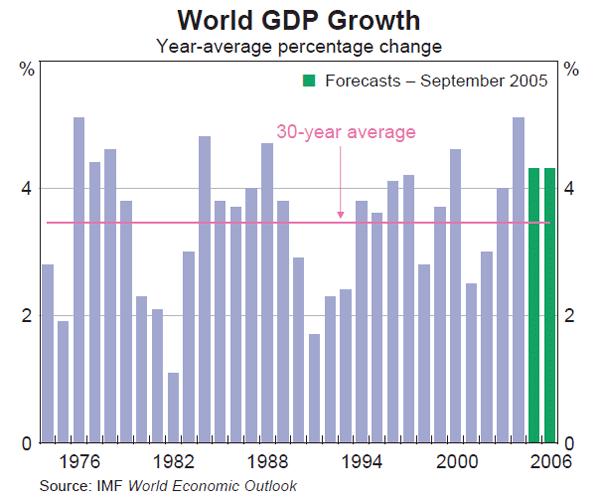
Developments in the oil market have remained a major source of uncertainty about the outlook. The impact of Hurricane Katrina on US supply capacity briefly pushed the price of West Texas Intermediate crude oil over US$70 per barrel in late August. Prices have since eased to around US$60 per barrel in early November; this is little changed relative to three months earlier (Graph 2). It is noteworthy that the higher price of oil has had little impact on core inflation outcomes for the major economies and global growth forecasts. Although headline inflation measures have increased significantly in the main industrialised economies, core measures excluding petrol have so far shown little upward movement stemming from second-round effects on other prices (Graph 3). The most recent IMF forecast for world growth in 2005 is virtually unchanged from the forecast published in April 2004, despite the projected level of oil prices for the year being double that for the earlier forecast. Similarly, a 40 per cent rise since April in the projected oil price for 2006 has not appreciably affected the IMF's forecast for growth in that year.
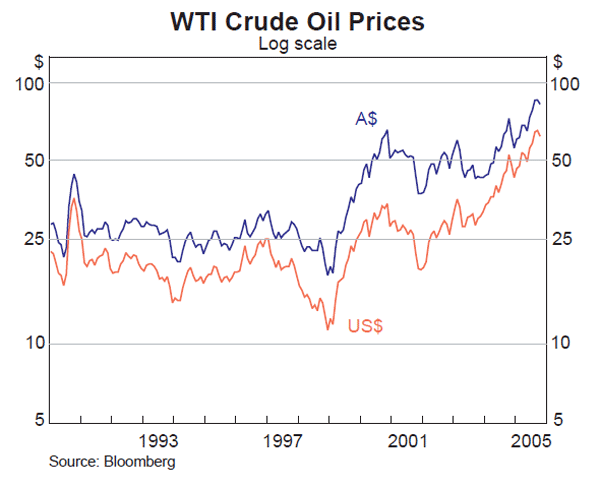
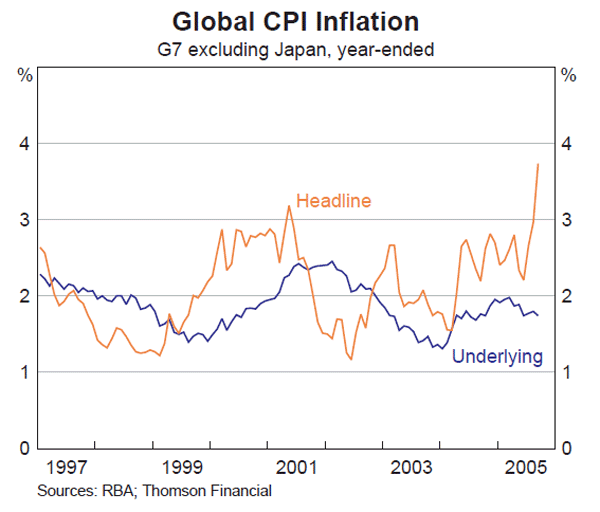
One reason why forecasts of global growth have not been scaled back is that the current high level of oil prices largely reflects strong demand; global oil supply has been rising overall, rather than contracting as occurred during the 1970s oil shocks (for more detail, see ‘Box A: Oil Price and Supply Developments’). This strength of global demand is also evidenced by the increases seen in other commodity prices. Furthermore, the major oil producers have spent more of their oil revenue than usual on imports, especially from Europe and Asia, thereby moderating the geographical redistribution of demand that results from higher oil prices.
United States
The US economy maintained its robust expansion into the second half of 2005, posting growth of 0.9 per cent in the September quarter and 3.6 per cent over the year (Graph 4), driven by ongoing strong consumption growth. While the effects of Hurricanes Katrina and Rita have resulted in some near-term weakness in the US economy, its underlying momentum remains strong. In the medium term, reconstruction activity should contribute to growth.
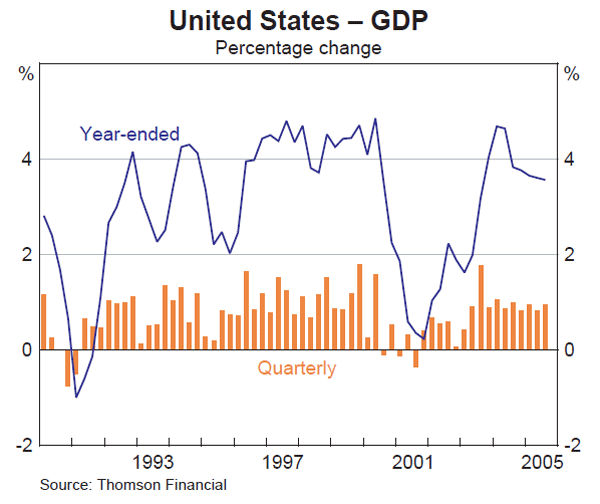
Consumption increased by 1 per cent in the September quarter and by 3.8 per cent over the year. This result reflected strength early in the quarter, with spending underpinned by the ongoing recovery in the labour market, rising asset prices and the resulting high level of consumer confidence. In nominal terms, house prices increased by 3.2 per cent in the June quarter and by 13.4 per cent over the year; this is the fastest growth in 25 years and the fastest real growth on record. Spending was more subdued later in the quarter, however, as motor vehicle discounting was scaled back and consumer sentiment fell sharply following Hurricanes Katrina and Rita and the associated spike in petrol prices.
Labour market conditions remained firm in the first part of the September quarter: non-farm payrolls grew by 1.8 per cent over the year to August, and the unemployment rate fell steadily to be 4.9 per cent in the month of August (Graph 5). However, the displacement of workers by Hurricanes Katrina and Rita has resulted in some weaker labour market indicators more recently. Non-farm payrolls fell by 35,000 in September; the unemployment rate edged higher to 5.1 per cent; and initial jobless claims surged well above 400,000 in early September, although this has since unwound. Nonetheless, some of these outcomes were not as weak as many observers expected, and the employment indices in the ISM surveys remained at solid levels in September.
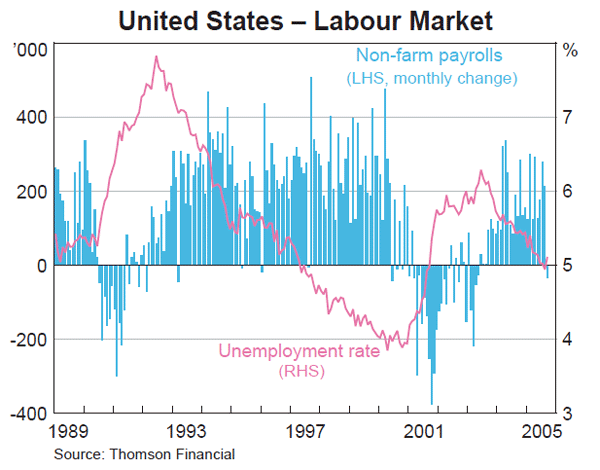
Business investment increased by 1.5 per cent in the September quarter, to be 7.8 per cent higher over the year. While this was slower than the rapid rate of almost 11 per cent recorded over 2004, conditions are supportive of further solid growth. Corporate profits continued to grow strongly in the June quarter, rising by 16 per cent over the year, to be at the highest share of GDP since the late 1960s (Graph 6). External financing conditions also remain favourable and business sentiment measures are consistent with solid growth, despite some recent volatility. Core capital goods orders fell in September, but are 5½ per cent higher over the year, suggesting ongoing strong growth in equipment investment.
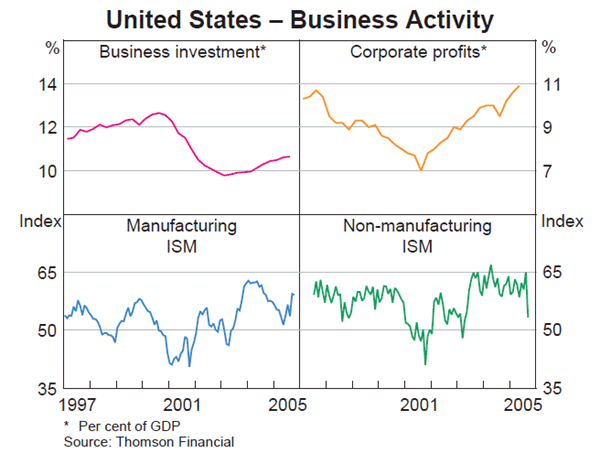
Headline CPI inflation rose to 4.7 per cent over the year to September, as petrol prices spiked following disruptions to production and refining caused by the hurricanes (Graph 7). Nevertheless, underlying annual inflation remained contained at around 2 per cent over the same period, according to the core measures of the CPI and the chain price index for personal consumption expenditure. However, the persistence of high energy prices and the pick-up in growth of unit labour costs, to 4.3 per cent over the year to the June quarter, point to ongoing inflationary pressure. The Federal Reserve has raised rates three times since the release of the last Statement, bringing the federal funds rate to 4 per cent.
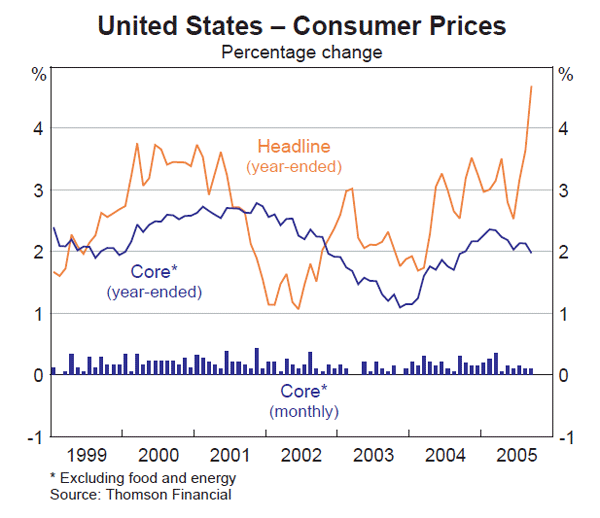
Asia-Pacific
Japan
Confidence in the Japanese recovery has increased, with real GDP growing by 0.8 per cent in the June quarter, to be 2.2 per cent higher over the year (Graph 8). Business activity continues to expand, underpinned by healthier balance sheets, while the firmer labour market is stimulating household spending. With business and consumer sentiment at high levels, prospects for sustained growth appear favourable.
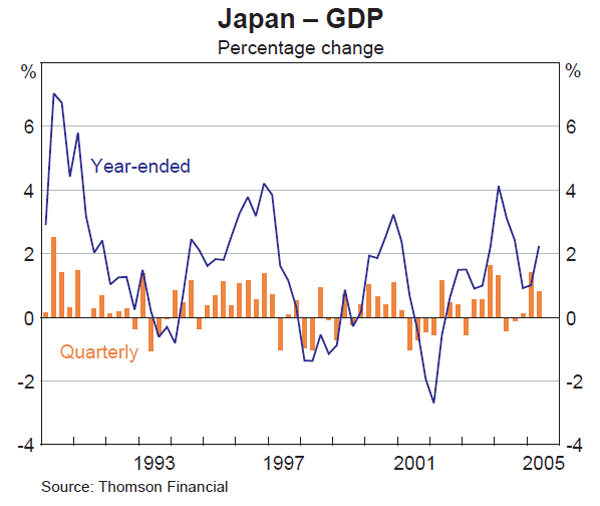
The business sector remains a key driver of the upswing, supported by rising demand and better financing conditions. Investment grew by 3.6 per cent in the June quarter, to be 7.6 per cent higher over the year. Forward indicators of investment are also positive: firms revised up their investment intentions in the September quarter Tankan survey, machinery orders have increased by 13.7 per cent over the year to August, and capacity utilisation remains at a high level in the manufacturing sector. Merchandise export growth has risen and should pick up further as the ITC sector recovers. Business sentiment indicators improved over the September quarter and are above long-run average levels. Corporate profits after interest were up by 14.5 per cent over the year to the June quarter, as firms appear to have worked off the excess debt and labour of the 1990s (Graph 9). Consistent with corporates' improved financial position, year-ended growth of underlying bank lending has turned positive for the first time since October 1998.
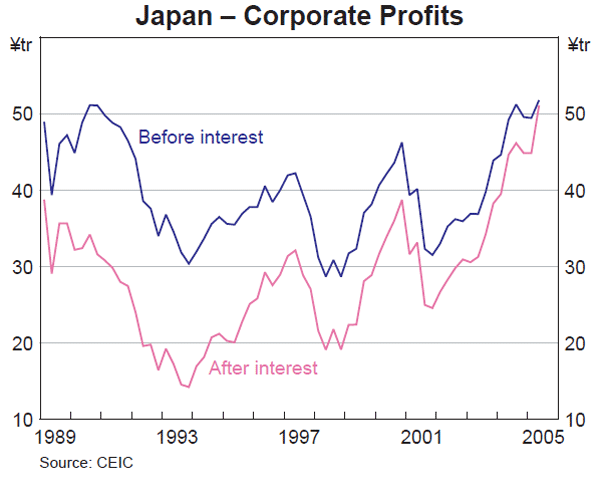
The outlook for the household sector has also firmed. Consumption increased by 0.6 per cent in the June quarter and consumer sentiment remains above long-run average levels. The faster pace of spending is being underpinned by improvements in the labour market, with cash earnings rising by 0.2 per cent over the year to September (Graph 10). Employment continues to expand at a solid pace, up by ½ per cent over the year to September, and the unemployment rate is at its lowest level in around seven years at 4.2 per cent. The job offers-to-applicants ratio, a forward indicator of employment growth, has increased to its highest level in 13 years, and employment intentions from business surveys point to continued hiring by firms.
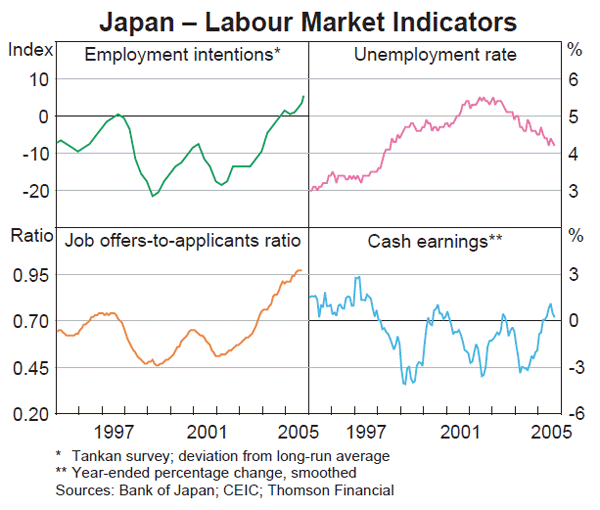
Domestic corporate goods prices have increased by 1.7 per cent over the year to September, driven by high oil and commodity prices, but moderate consumer price deflation persists. The core CPI, which excludes fresh food prices, fell by 0.1 per cent over the year to September, with regulatory changes to electricity and telecommunications contributing to falling consumer prices over the past year. Asset prices have improved, with land prices increasing in the Tokyo area for the first time in 15 years and equity prices rising to their highest level in over four years.
China
The Chinese economy has carried significant momentum into the second half of 2005, with real GDP increasing by 9½ per cent over the year to the September quarter. Year-ended growth of nominal industrial production also remains strong at 16½ per cent in September. While the mix of GDP growth appears better balanced than in early 2004, growth is still highly dependent on investment spending. The value of urban fixed asset investment increased by almost 30 per cent over the year to September, considerably faster than the pace of retail sales growth, which nevertheless remains strong at around 13 per cent. Year-ended growth of the money stock also picked up noticeably, to nearly 18 per cent in September, above the official target of 15 per cent for 2005, while credit grew by around 14 per cent over the same period. Export growth slowed to 26 per cent over the year to September, while growth of imports picked up to a fairly similar rate. Although the trade surplus has narrowed in recent months, it remains large by historical standards, so a significant widening of the current account surplus is likely in 2005.
Inflationary pressures remain contained despite strong output growth and rising commodity prices. Consumer price inflation eased to 0.9 per cent over the year to September, as the effect of last year's run-up in food prices faded; consumers have been relatively insulated from rising fuel costs by government regulation of petrol prices. Prices continue to rise more rapidly at the producer level, but the pace has slowed, to 4½ per cent over the year to September.
Other Asia-Pacific
Growth in the rest of east Asia appears to be picking up, after easing in 2004. Real GDP expanded by 1.4 per cent in the June quarter to be 4.3 per cent higher over the year (Graph 11). Quarterly GDP growth was particularly strong in Hong Kong and Singapore; Hong Kong continues to benefit from increasing integration with China, while activity in Singapore was boosted by its biomedical industry. Real GDP rebounded in Thailand as tourism improved following tsunami-related falls in the March quarter, and the recovery in Korea continued to gain traction. September quarter data from Singapore and Korea show further gains in year-ended GDP growth.
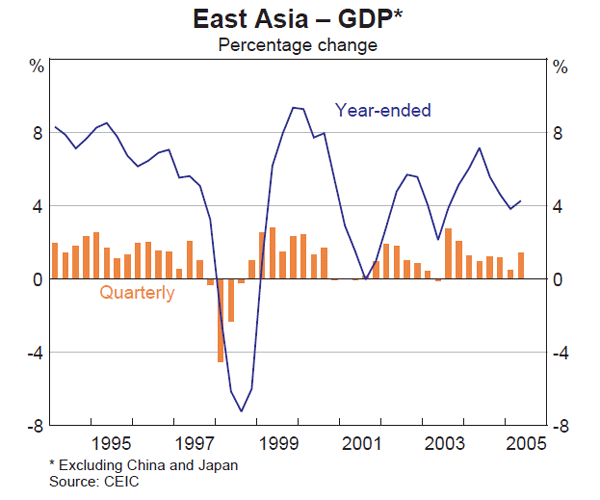
More recent indicators are also consistent with firmer growth in the region, due in part to recovering demand for ITC products. After a flat patch earlier in the year, growth of aggregate industrial production rebounded to 7.2 per cent over the year to August, and merchandise export growth picked up to 15.2 per cent over the same period. Progress has been made in reducing ITC inventories, and ITC exports have accelerated to show growth of around 20 per cent over the year to August. World semiconductor sales increased by nearly 9 per cent in the September quarter, and sales from non-Japan Asia have been growing at a stronger rate than the total. The US semiconductor equipment book-to-bill ratio, an indicator of future production, has risen to be above one in August and September, implying that orders are running above current shipments.
Domestic demand remains firm across most of the region. Aggregate investment growth picked up in the June quarter, spurred by relatively high rates of capacity utilisation. Solid consumption growth has been encouraged by favourable financial and labour market conditions. The unemployment rate continues to trend down in Hong Kong, Malaysia, Singapore and Taiwan. Growth of domestic demand in Korea had lagged behind the rest of the region in the past few years, as households repaired their balance sheets, but conditions have recently been improving. Consumption increased for the fifth consecutive quarter in September, to be 3.9 per cent higher over the year. The credit card delinquency ratio is now back below the levels seen prior to the credit card crisis, and household demand for credit has begun to increase.
High oil prices continue to put pressure on headline consumer price inflation across the region, and in some cases this has been amplified by reductions in fuel subsidies. Adverse weather conditions have also boosted food prices in some countries. Aggregate consumer price inflation picked up to 3.9 per cent over the year to September, from a low of 2.9 per cent earlier in the year. Although interest rates remain relatively low, monetary policy has been tightened across the region in the past three months. Indonesia experienced a short bout of financial market turbulence in August, as higher oil prices raised concerns about the budgetary cost of fuel subsidies and falling foreign reserves. In early October, the Indonesian government announced a reduction in fuel subsidies, which raised average fuel prices by 126 per cent. As a result, Indonesian consumer price inflation jumped to almost 18 per cent over the year to October, from 9.1 per cent over the year to September. In response to both the market turbulence and inflationary pressures, Bank Indonesia has increased interest rates by a total of 375 basis points since early August.
Strengthening growth in the Indian economy is providing a significant boost to the global expansion. In purchasing power parity terms, India is now the world's fourth-largest economy, and accounted for 6 per cent of world GDP in 2004. Real GDP expanded by 2.4 per cent in the June quarter and by 8.2 per cent over the year, which is well above India's average growth rate of 5½ per cent over the past 30 years (Graph 12). The manufacturing and services sectors contributed strongly to growth, while agricultural output was weaker, following last year's below-average monsoon season. More recently, industrial production grew by 7.4 per cent over the year to August, and both imports and exports grew strongly over the year to the September quarter, despite some monthly volatility. Wholesale price inflation picked up to 4.0 per cent over the year to September, in part reflecting the government's recent decision to raise administered fuel prices. The Reserve Bank of India raised interest rates by 25 basis points in October to 5.25 per cent.
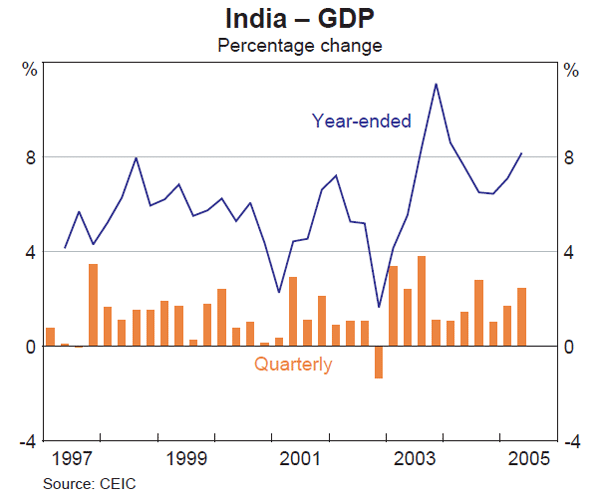
In New Zealand, economic growth has eased from the rapid pace of 2004, but remains firm. Real GDP surprised on the upside in the June quarter, increasing by 1.1 per cent in the quarter and by 2.6 per cent over the year, on strong domestic demand. While consumption and dwelling investment growth eased, business investment growth picked up in response to high profitability and capacity utilisation. The labour market remains tight, with the unemployment rate at 3.7 per cent in the June quarter. The Reserve Bank of New Zealand (RBNZ) raised the official cash rate by 25 basis points to 7 per cent in late October. Annual consumer price inflation rose to 3.4 per cent in the September quarter, which is above the RBNZ's target band of 1–3 per cent.
Europe
Conditions in the euro area remained weak in the June quarter, as domestic demand faltered. Euro area real GDP grew by only 0.3 per cent in the June quarter, and was 1.1 per cent higher over the year (Table 2). Growth in domestic demand in the quarter was subdued, with a run-up in inventories the main contributor to output growth. Growth has slowed in most countries over the past year: consumption fell in Germany and France, leading to negligible growth in both countries in the June quarter, while stronger growth in Italy and the Netherlands might simply have been a bounce-back from weak first-quarter results. The exception is Spain, where solid growth has continued, driven by ongoing increases in house prices and investment.
| March quarter 2005 |
June quarter 2005 |
Year to June quarter 2005 |
|
|---|---|---|---|
| Euro area | 0.4 | 0.3 | 1.1 |
| – Germany | 0.8 | 0.0 | 0.6 |
| – France | 0.4 | 0.1 | 1.3 |
| – Italy | −0.5 | 0.7 | 0.1 |
| – Spain | 0.9 | 0.9 | 3.4 |
| – Netherlands | −0.8 | 1.2 | 1.0 |
| United Kingdom | 0.3 | 0.5 | 1.5 |
|
Source: Thomson Financial |
|||
More recent indicators suggest household consumption remained subdued in the third quarter, with consumers pessimistic about prospects for recovery and concerned about ongoing political uncertainty; euro area retail sales grew by 1.6 per cent over the year to August, and fell in Germany. However, conditions in the labour market are gradually improving; the euro area unemployment rate fell to 8.6 per cent in August, from 8.9 per cent at the end of 2004.
There have been some tentative signs of improvement in recent data for the business sector. Industrial production picked up in August to be 2.5 per cent higher in year-ended terms, and the upward trajectory of the manufacturing PMI since May is suggestive of further growth in the near future. Export orders were 4.4 per cent higher over the year to August, which points to strengthening exports and production. But among the larger countries, the strength in industrial production has so far been concentrated in Germany, with production weaker in France and Italy. Nevertheless, business confidence has strengthened since its trough in May, and was above long-run average levels in October.
Headline inflation was 2.5 per cent over the year to October, due in large part to high petrol prices (Graph 13). The effect of energy prices on underlying inflation has been muted to date, with core inflation of only 1.3 per cent over the year to September. Nevertheless, the ECB is expressing greater concern about the potential for second-round effects of oil prices on inflation and wages.
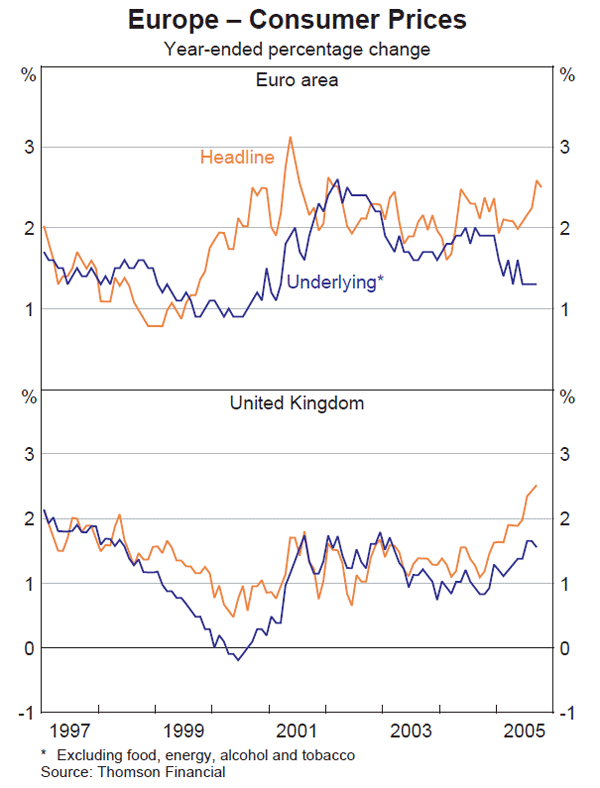
The UK economy has slowed sharply since mid 2004, with domestic demand decelerating in response to higher interest rates and the cooling housing market. According to preliminary data, GDP grew by 0.4 per cent in the September quarter, to be 1.6 per cent higher over the year. This slowing is also reflected in the labour market; the claimant count unemployment rate rose to 2.8 per cent in September from a low of 2.6 per cent at the start of the year. However, the housing market appears to have stabilised, and house prices rose by around 3 per cent over the year to September. Furthermore, conditions in the business sector appear to be improving, with manufacturing production having recovered somewhat since its sharp fall earlier in the year. The manufacturing PMI has risen sharply since May, suggesting the recovery in production will continue, and other indicators of business confidence imply that there is some cautious optimism amongst firms.
After around 18 months in which the headline inflation rate was below the 2 per cent target adopted in December 2003, hikes in oil prices have lifted it to 2.5 per cent over the year to September; underlying inflation rose to 1.6 per cent over the same period. The Bank of England's Monetary Policy Committee reduced the repo rate in August, from 4¾ per cent to 4½ per cent, citing subdued output growth.
Box A: Oil Price and Supply Developments
Benchmark oil prices have more than doubled over the past two years, and have risen by around 40 per cent since the end of 2004. Disruptions to extraction and refining facilities resulting from hurricanes in the US Gulf Coast region led to a spike in prices in late August and early September, with prices briefly exceeding US$70 before retracing to around US$60 by early November.
Aside from the hurricane-related volatility, the significant increase in oil prices over recent years has generally been viewed as driven by strong global demand, rather than restraints on supply. Between late 2003, when prices began rising sharply, and July this year (the latest period for which world oil supply data are available) world oil production rose by 6.0 per cent, or 4.1 million barrels per day (bpd) (Graph A1). OPEC producers accounted for 3.3 million bpd of this increase, boosting their production by 12 per cent over this period. Despite this supply expansion, benchmark oil prices roughly doubled in US$ terms over the same period.
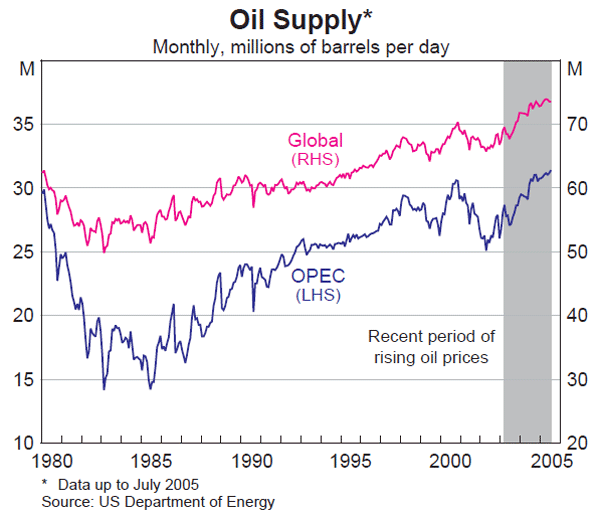
These developments contrast with those in earlier episodes, such as the OPEC oil shocks of the 1970s, when supply declined and the increase in prices was substantially larger and more sudden. Over the period September to November 1973, OPEC nations cut production by around 12 per cent, reducing overall world supply by about 7 per cent (Graph A2). Similarly, OPEC oil supply fell by around 9 per cent over the period October 1978 to February 1979, leading to a decline in total supply of 4 per cent. Subsequent sharp increases in prices, such as that seen in late 1990 prior to the first Gulf War, were also associated with falls in production.
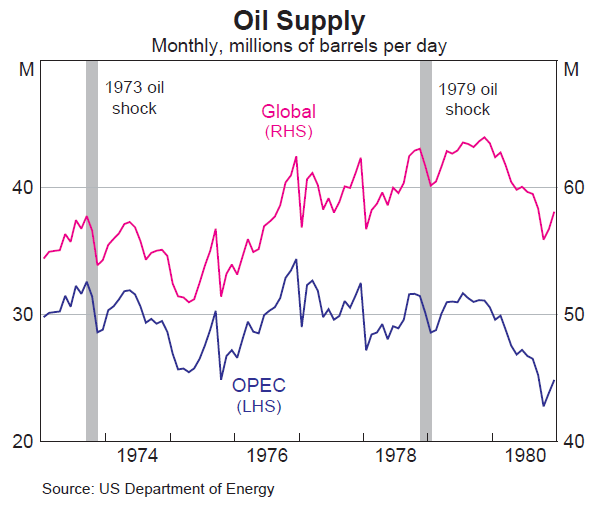
An additional perspective on the current shock is provided by developments in futures prices for oil. Over the past decade or so, swings in spot oil prices have typically been viewed as temporary, so longer-term futures prices normally reacted little to them. In contrast, the strength in demand that has recently driven prices higher is generally expected to be sustained, especially given that more than one-third of the increase in demand has come from China and other fast-growing parts of Asia. Six-year futures prices have therefore risen sharply, from US$37 per barrel in late 2004 to US$55 in early November. Futures prices are now around 110 per cent higher than at the end of 2003, similar to the increase in spot prices.
International and Foreign Exchange Markets
Money markets
The US Federal Reserve has continued to tighten monetary policy over recent months. Since mid 2004 it has increased the policy rate by 25 basis points at each of its twelve meetings, a cumulative tightening of 300 basis points (Graph 14). This has lifted the Fed funds rate to 4 per cent, which is still a little below the average over the past decade. Market expectations about the pace of future tightening have fluctuated over the past three months, mainly due to uncertainty caused by hurricanes. Following Hurricane Katrina, markets significantly scaled back their expectations such that only one further tightening by the Fed was anticipated. However, after it became clear that the Fed did not expect any ongoing threat to economic growth, whereas higher energy costs had the potential to add to inflation pressures, markets once again priced in more tightening. This has been reinforced by the release of data showing that the US economy remains strong as well as further comments by FOMC members highlighting the risks to the inflation outlook. Markets are currently expecting the Federal Reserve to raise rates by a further 75 basis points over the next six months, but rates are expected to plateau beyond that.
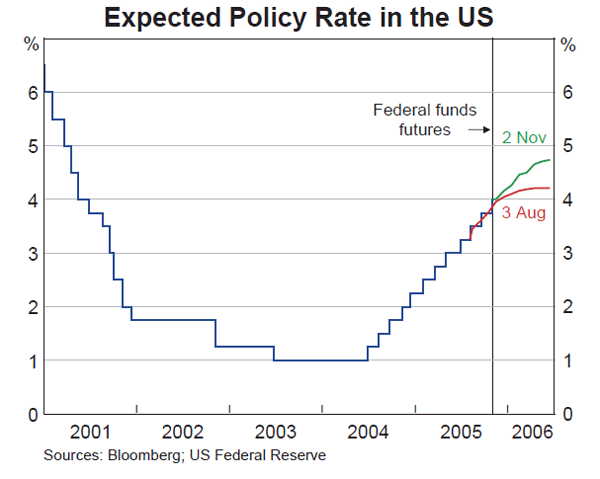
The European Central Bank (ECB) has not changed monetary policy since June 2003, but recent comments from ECB officials have highlighted growing concerns about the effect on inflationary expectations of high oil prices. Consequently, markets have factored in the possibility of a 25 basis point increase in the policy rate early in 2006. Similarly, although the Bank of Japan (BoJ) has not changed the stance of monetary policy for a long period, some market participants have interpreted recent BoJ comments that deflation is expected to end next year as a signal that it may soon start to move away from the quantitative easing policy (Table 3).
| Current level Per cent | Change over 2005 Basis points | Market expectations for next 6 months |
|
|---|---|---|---|
| US | 4.00 | 175 | ↑ 75 bps |
| Euro area | 2.00 | 0 | ↑ 50 bps |
| Japan | 0.00 | 0 | no change |
| UK | 4.50 | −25 | no change |
| Canada | 3.00 | 50 | ↑ 50 bps |
| Australia | 5.50 | 25 | no change |
| NZ | 7.00 | 50 | ↑ 25 bps |
| Sweden | 1.50 | −50 | ↑ 25 bps |
| Switzerland | 0.75 | 0 | ↑ 25 bps |
|
Sources: central banks |
|||
The Bank of Canada increased its policy rate by 25 basis points at both its September and October meetings to 3 per cent, reflecting increased inflationary pressures. Markets are expecting rates to be increased a further 50 basis points over coming months. The Reserve Bank of New Zealand increased its policy rate by 25 basis points to 7 per cent at its late October meeting, against a background of rising inflation, a strong economy and continuing rises in house prices.
In contrast, the official policy rate in the UK was reduced by 25 basis points to 4.5 per cent in August. The policy rate was not changed at the subsequent two meetings, and markets expect the Bank of England to keep it steady over the coming six months. Elsewhere in Europe, rates have remained unchanged in Sweden and Switzerland over the past three months.
In emerging markets, Indonesia's central bank has increased its interest rate target by a cumulative 375 basis points, to 12¼ per cent, in five steps since the new monetary framework was introduced in July. The increases were aimed at stemming speculative pressure against the rupiah as well as combating mounting inflationary pressures. Central banks in the Czech Republic, Chile, Taiwan, Thailand, South Korea, the Philippines and India also tightened monetary policy, citing increased inflationary pressures. The People's Bank of China (PBoC) increased the interest rates that Chinese banks can pay on US and Hong Kong dollar denominated deposits in both August and October by a total of 87.5 basis points. This was an attempt to ease upward speculative pressure on the renminbi. In other emerging markets, Hungary, Poland, Mexico and Brazil lowered policy rates, as inflation concerns eased.
Bond yields
Yields on US 10-year government bonds have continued to fluctuate broadly within the 4 to 4½ per cent range which has generally prevailed over the past year. Yields fell to the bottom of the range in early September on fears that Hurricane Katrina would have a significant dampening impact on economic growth. Over the past two months, however, yields have risen back to be just above 4½ per cent following the publication of robust economic data, as well as comments from the Federal Reserve that the disruption to economic activity from the hurricane was likely to be temporary and that monetary policy remains expansionary. The recent fluctuations in the nominal yield have been due primarily to variations in real yields, with inflation expectations remaining relatively stable (Graph 15).
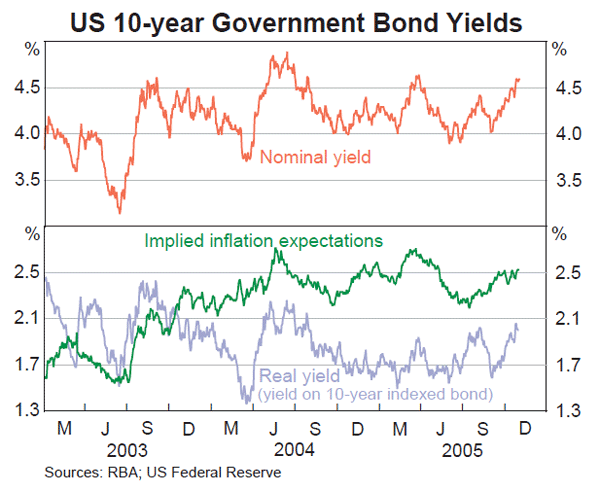
The German 10-year bond yield fell to a new post-war low of around 3 per cent in September, in part due to political uncertainty surrounding the German election (Graph 16). Yields have since risen from these lows as comments from ECB speakers have highlighted the risk that high oil prices will flow through to inflation. Nonetheless, with the economic outlook more favourable in the US, the spread between German and US 10-year bond yields has widened further; yields in the two countries had been fairly similar up to mid 2004. Yields on 10-year Japanese government bonds increased over the past three months as optimism about the economic outlook and prospects for further economic reform increased following Prime Minister Koizumi's clear election win.
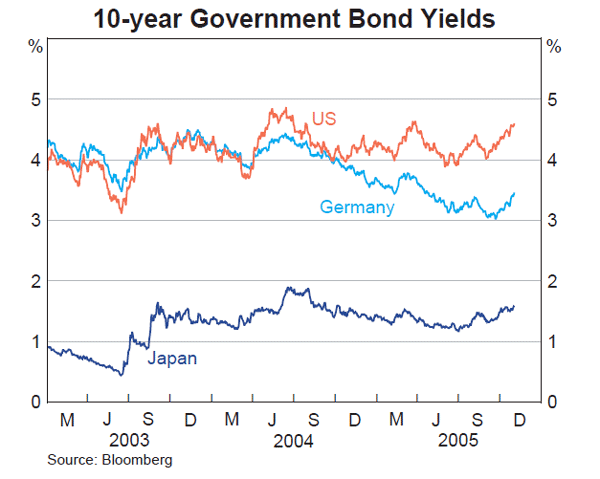
Bond yields on emerging-market and corporate debt remain near historically low levels. Emerging-market spreads have been little changed over the past three months, with the exception of Indonesia where spreads on sovereign debt widened significantly reflecting concerns about the impact of higher oil prices on the fiscal position (Graph 17). Despite renewed pressure on the automotive sector after a US auto parts supplier filed for bankruptcy, US corporate spreads to Treasuries have increased only marginally over the past three months.
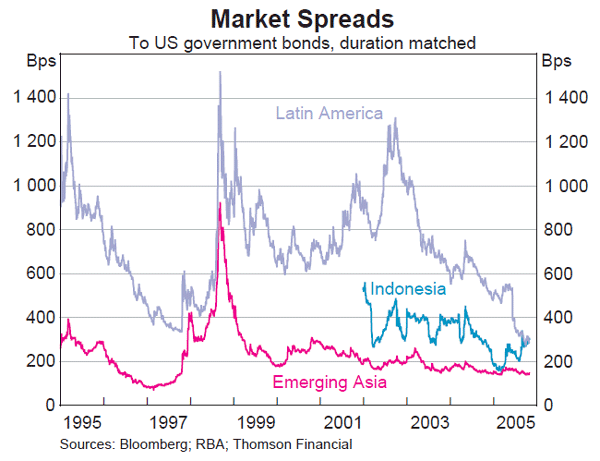
Equity markets
The performance of the major global equity markets has diverged over the past three months (Graph 18, Table 4). US share prices have fallen slightly on concerns about the impact of higher oil prices on consumer spending and fears that inflationary pressures are building. Stocks related to discretionary consumer spending, including auto-related and home furnishings stocks, have been particularly weak. In contrast Japanese equity prices have increased significantly over this period, with the TOPIX up by around 24 per cent. A more positive economic outlook, as well as heightened expectations of further reform after the Koizumi government won an absolute majority in the recent elections, has supported the gains, although concerns that growth in global consumption may slow if oil prices remain high tempered the overall rise. European equity prices also increased strongly in the first part of the period, but fell back more recently on concerns about oil prices and inflationary pressures, and are broadly unchanged over the three months.
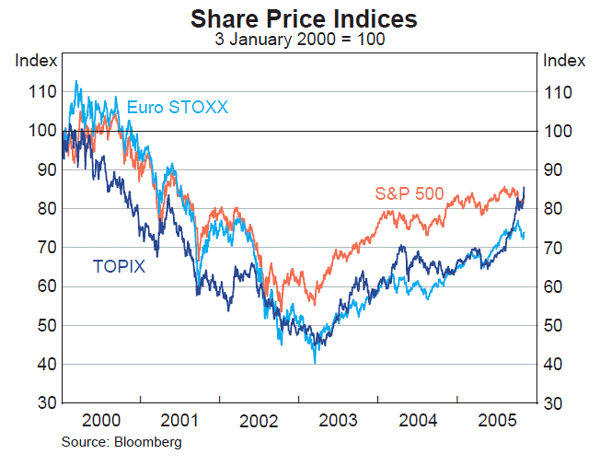
| Since 2000 peak |
Since 2003 trough |
2005 to date |
Since the previous Statement |
|
|---|---|---|---|---|
| United States | ||||
| – Dow Jones | −11 | 39 | −3 | −1 |
| – S&P 500 | −20 | 52 | 0 | −1 |
| – NASDAQ | −58 | 69 | −1 | −2 |
| Euro area | ||||
| – STOXX | −35 | 85 | 14 | 1 |
| United Kingdom | ||||
| – FTSE | −23 | 63 | 11 | 1 |
| Japan | ||||
| – TOPIX | −16 | 91 | 28 | 24 |
| Canada | ||||
| – TSE 300 | −7 | 70 | 14 | 0 |
| Australia | ||||
| – ASX 200 | 32 | 65 | 10 | 2 |
|
Source: Bloomberg |
||||
In emerging markets, average share prices in Latin America have risen by around 10 per cent since the previous Statement, with particularly strong gains in Brazil and Mexico. They have also increased in South Korea and India with share prices up around 35 per cent over the year to date in the former and around 20 per cent in the latter. In contrast, share prices fell in Taiwan and Indonesia, reversing some of the strong growth seen earlier this year.
Exchange rates
The US dollar has appreciated against most of the major currencies over the past three months (Table 5, Graph 19). The dollar has been particularly strong against the yen, appreciating by 4 per cent to its highest level since September 2003 (Graph 20). This was despite favourable political and economic news in Japan. Against the euro, the dollar has appreciated by around 2 per cent and is up 12 per cent since its low point in late 2004. On a major currency trade-weighted basis the US dollar has appreciated 1 per cent over the past three months to be 8 per cent higher over the year to date. This rise has been limited in part by the strength of the Canadian dollar, which reached a 13-year high against the US dollar due to strength in commodity prices and policy tightening by the Bank of Canada.
| Since USD peak Jan 2002 |
2005 to date | Since last Statement |
|
|---|---|---|---|
| South Africa | −42.3 | 17.3 | 2.8 |
| New Zealand | −39.0 | 3.7 | 0.0 |
| Australia | −30.6 | 5.0 | 2.9 |
| Euro area | −28.6 | 12.3 | 2.3 |
| Canada | −26.2 | −1.8 | −2.9 |
| Sweden | −25.6 | 19.9 | 5.5 |
| Switzerland | −25.1 | 12.1 | 1.3 |
| South Korea | −21.0 | 0.4 | 2.3 |
| United Kingdom | −20.7 | 8.0 | 0.5 |
| Japan | −12.4 | 13.9 | 4.2 |
| Brazil | −7.7 | −15.7 | −3.9 |
| Singapore | −7.6 | 3.8 | 2.4 |
| Thailand | −7.3 | 4.9 | −0.8 |
| India | −6.5 | 4.0 | 3.8 |
| Taiwan | −3.9 | 5.8 | 5.1 |
| Indonesia | −3.2 | 8.4 | 2.8 |
| China | −2.3 | −2.3 | −0.3 |
| Malaysia | −0.6 | −0.6 | 0.8 |
| Philippines | 6.9 | −2.7 | −2.2 |
| Mexico | 17.1 | −3.7 | 0.8 |
| Majors TWI | −24.3 | 7.5 | 1.1 |
| Broad TWI | −13.9 | 3.6 | 1.2 |
|
Source: RBA |
|||
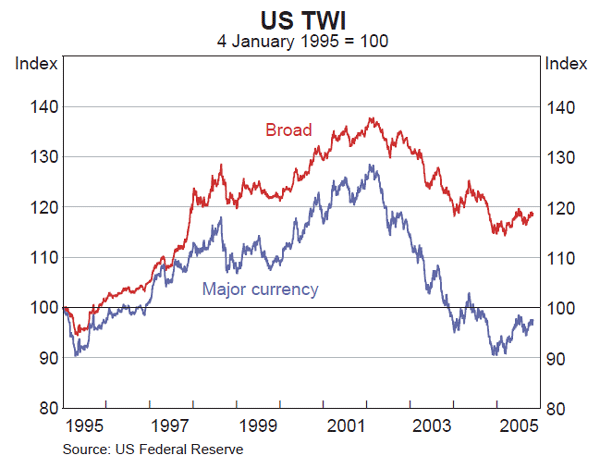
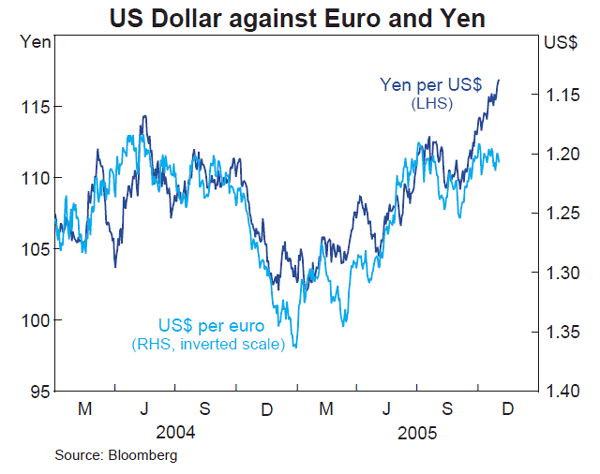
The Chinese renminbi has remained fairly stable against the US dollar following its 2.1 per cent revaluation in July, appreciating by just 0.3 per cent since then (Graph 21). Expectations for further appreciation indicated by the non-deliverable forward (NDF) market have been scaled back slightly to 3½ per cent over the next year. In late September the Chinese authorities widened the trading band for the renminbi against non-US dollar currencies to ±3 per cent around the daily fixing rate, from ±1½ per cent previously. The band against the US dollar was retained at ±0.3 per cent.
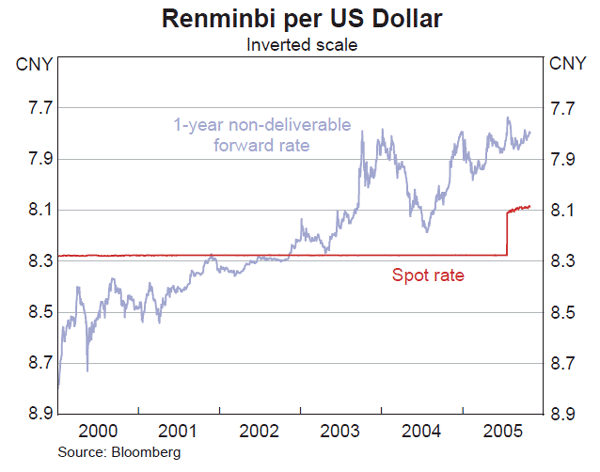
The Indonesian rupiah weakened noticeably in late August as the interaction of rising oil prices and government fuel subsidies heightened concerns about the fiscal position. However, the currency recovered over subsequent months after official interest rates were raised and fuel subsidies were reduced (Graph 22). The Monetary Authority of Singapore (MAS) reiterated the policy it adopted in April 2004 of allowing a modest and gradual appreciation of the Singapore dollar against a basket of currencies. Other east Asian currencies have generally depreciated modestly against the US dollar over the past three months.
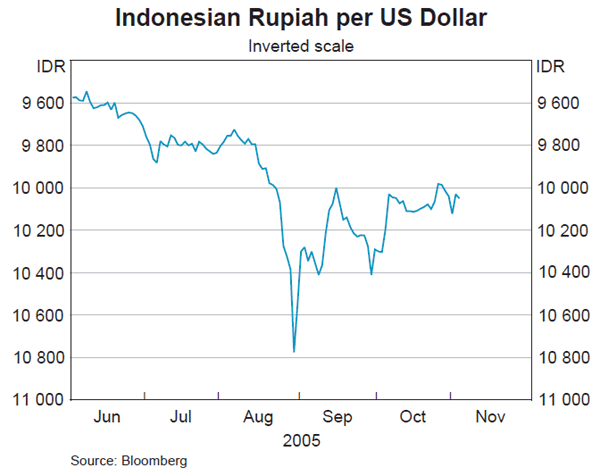
Australian dollar
The Australian dollar has depreciated over recent months against the US dollar and is slightly lower on a trade-weighted basis (Graph 23). The fall against the US dollar was partly offset by rises against some Asian currencies including the yen (Graph 24). Against the US dollar, the exchange rate is currently just below the lower end of the trading range of US75 cents to US80 cents that has prevailed since late last year, and is around the middle of the year's range on a trade-weighted basis. Over this period, the exchange rate of the Australian dollar has been affected by countervailing forces: the interest rate differential relative to the US has narrowed, putting downward pressure on the currency, and A$ Eurobond issuance has declined noticeably; but commodity markets have strengthened, which has been supportive for the currency.
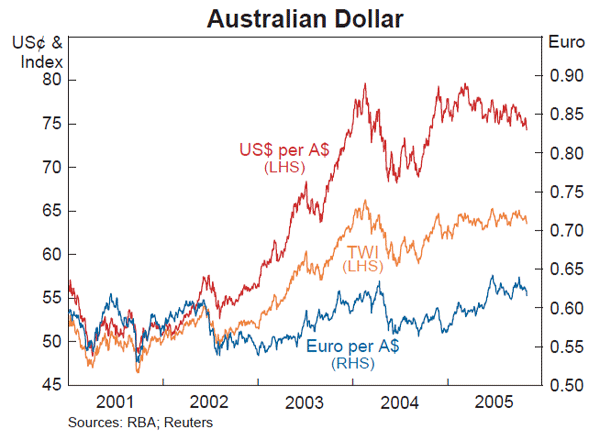
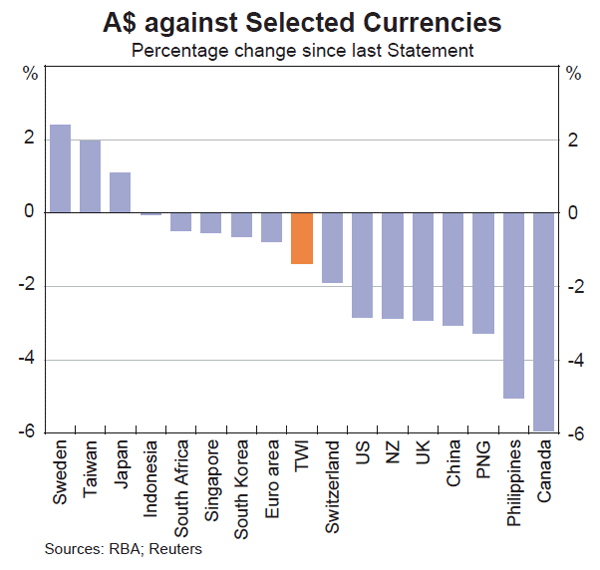
Investor sentiment towards the Australian dollar remains favourable, with speculators continuing to hold net long positions against the US dollar on the Chicago Mercantile Exchange (Graph 25). The Australian and Canadian dollars are the only major currencies in which speculative positioning remains long against the US dollar. Volatility in the Australian dollar is below its post-float average, following a brief spike around the time of Hurricane Katrina (Graph 26).
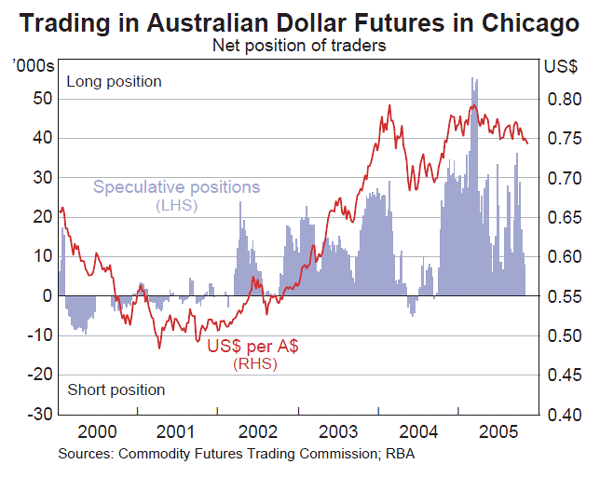
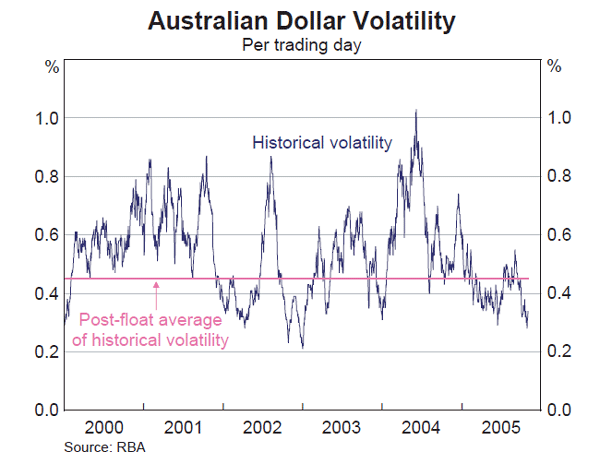
The Bank has continued to accumulate foreign exchange reserves over the past few months, buying foreign exchange when the exchange rate was toward the upper end of its recent trading range. Overall, net reserves have increased to $27¾ billion, from $26½ billion at the end of July. The Bank's holdings of foreign exchange under swap arrangements, which are largely determined by domestic liquidity management operations, declined by A$3¼ billion over the past three months to A$27 billion.
Domestic Economic Conditions
Domestic expenditure recorded solid growth over the first half of 2005, after slowing over 2004 from the rapid rates registered in the two preceding years. In the June quarter, business investment, public demand and dwelling investment all increased strongly, while household consumption continued to grow at a moderate pace. Net exports again declined in the quarter, although by less than in earlier quarters. Overall, real GDP was estimated to have increased by 1.3 per cent in the June quarter and by 2.6 per cent over the year (Table 6).
| September qtr 2004 |
December qtr 2004 |
March qtr 2005 |
June qtr 2005 |
Year to June qtr 2005 |
|
|---|---|---|---|---|---|
| Domestic final demand | 1.0 | 1.2 | 0.1 | 1.9 | 4.3 |
| Change in inventories(a) | −0.1 | −0.4 | 0.8 | −0.1 | 0.2 |
| GNE | 0.9 | 0.8 | 0.9 | 1.8 | 4.4 |
| Net exports(a) | −0.7 | −0.6 | −0.4 | −0.2 | −1.9 |
| GDP | 0.4 | 0.3 | 0.5 | 1.3 | 2.6 |
| Memo item: | |||||
| Real GDP adjusted for changes in terms of trade |
0.6 | 0.7 | 0.9 | 2.4 | 4.6 |
|
(a) Contributions to GDP growth Source: ABS |
|||||
The outlook for growth remains favourable, reflecting in particular the stimulus coming from the strong terms of trade. Conditions in the business sector are positive, with profitability and capacity utilisation at high levels, and activity data for the housing sector continue to suggest a mild downturn by historical standards. Household consumption growth is likely to remain moderate, with the impact of higher petrol prices and the levelling-out in house prices partly offsetting the support to household income from the favourable labour market conditions and recent tax cuts. Slower growth in domestic demand, together with a gradual recovery in exports, should see the drag from net exports continue to ease. Rural exports in particular are expected to pick up gradually following the improvement in farm sector conditions in recent months.
Household sector
Consumption grew by 0.7 per cent in both the March and June quarters, and by 3.0 per cent over the year, down from a peak annual rate of around 6½ per cent in early 2004. In the June quarter, expenditure on household services increased solidly, while spending on goods was unchanged. More recently, the volume of retail sales was up by 0.5 per cent in the September quarter and sales of motor vehicles increased by 1.8 per cent (Graph 27). Nonetheless, consumer sentiment has fallen in recent months, with the Westpac-Melbourne Institute measure a little below its long-run average in October. The decline in sentiment has been attributed mostly to higher petrol prices, although concerns about the impact of terrorist attacks and natural disasters abroad have also been noted. The large impact of higher petrol prices on sentiment is perhaps surprising, given that petrol represented only around 3 per cent of household consumption expenditure in 2004/05 (see Box C for further discussion of oil usage in the Australian economy).
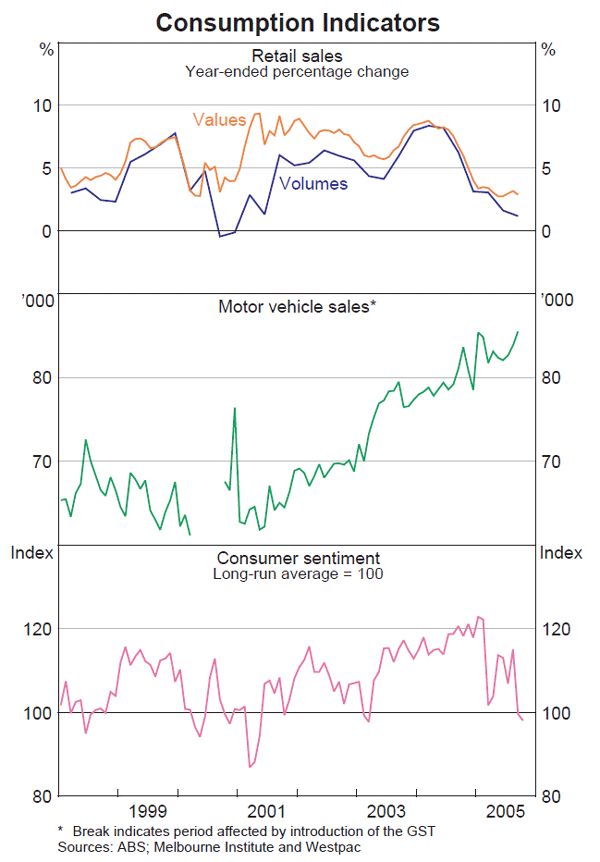
Household consumption growth over the past year has been in line with income growth, leaving the saving rate broadly unchanged. Household credit growth has continued to outpace growth in both income and assets. The growth in household borrowing contributed to an increase in debt-servicing costs, which rose to 9.8 per cent of disposable income in the June quarter (Graph 28). In addition, revised aggregate data suggest that the household sector is still withdrawing equity from the housing stock, although at a much slower pace than the peak in 2003.
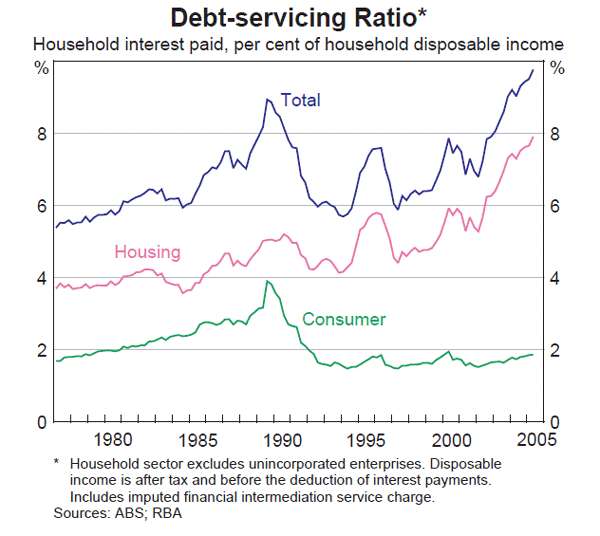
Housing
Construction
After a fall of 5 per cent over the three quarters to March quarter 2005, dwelling investment increased by 3.3 per cent in the June quarter, with increased spending on both new construction and alterations and additions. The strength in the June quarter came despite an earlier fall in commencements, and partly reflected a pull-forward in activity ahead of changes to Victoria's environmental legislation effective 1 July. Looking through the volatility, housing indicators remain weakest in New South Wales and Victoria, while conditions in other states have been firm (Graph 29).
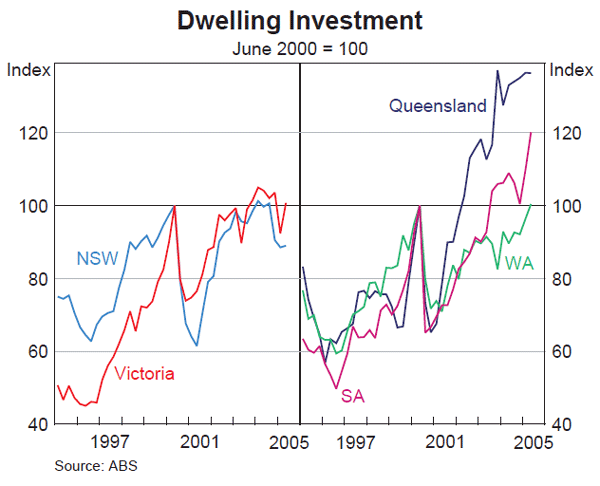
Forward-looking indicators of housing activity point to some near-term easing in construction. The number of building approvals declined by 12 per cent in the September quarter, with falls in approvals for both houses and medium-density dwellings (Graph 30). The Housing Industry Association new home sales series – which are commitments to build – has also recently declined. Nonetheless, with further large amounts of work yet to be done, especially in the more buoyant states, the current downturn in house building activity is likely to be shallow by the standards of previous cycles.
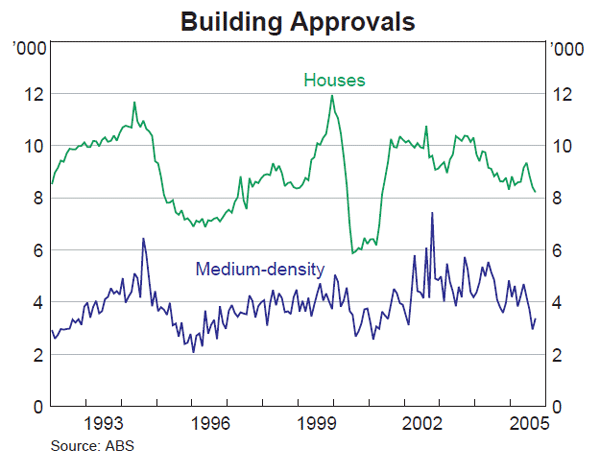
Financing and prices
The value of housing loan approvals fell by 1.8 per cent in the three months to August compared with the previous three months, as a decline in demand by investors more than offset increased demand by owner-occupiers (Graph 31). However, at around $13 billion, the monthly value of loan approvals was still above its average level in 2004. The value of loan approvals for owner-occupiers was 12 per cent above the level of a year earlier, mostly due to an increase in loans for the purchase of existing dwellings, and remains around its late 2003 level. In contrast, the value of loan approvals for investors was down around 4 per cent over the year and by around one-third from its late 2003 peak. Housing credit growth has also moderated in recent months, recording an annualised rate of 12.1 per cent for the six months to September, consistent with the current more subdued level of loan approvals.
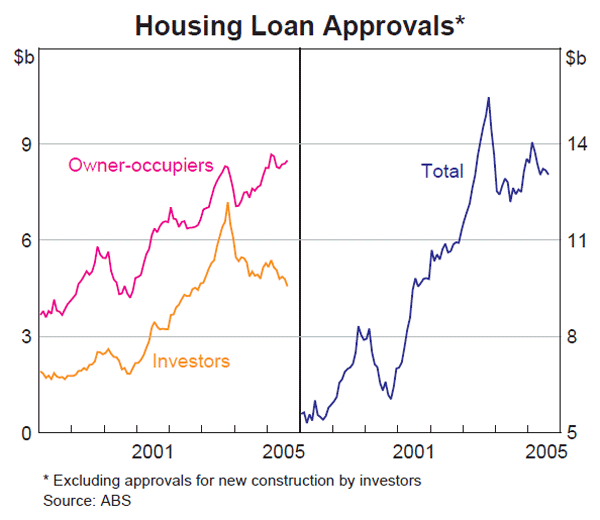
Average nationwide house prices appear to have remained fairly stable in recent quarters (Graph 32, Table 7). The APM composition-adjusted measure suggests that nationwide prices fell modestly in the September quarter but were broadly unchanged over the year. Most measures continue to suggest that house prices in Sydney have softened over the past year. House prices in Perth appear to have risen strongly over the same period, while the different measures suggest reasonably flat or slightly higher prices in other capitals.
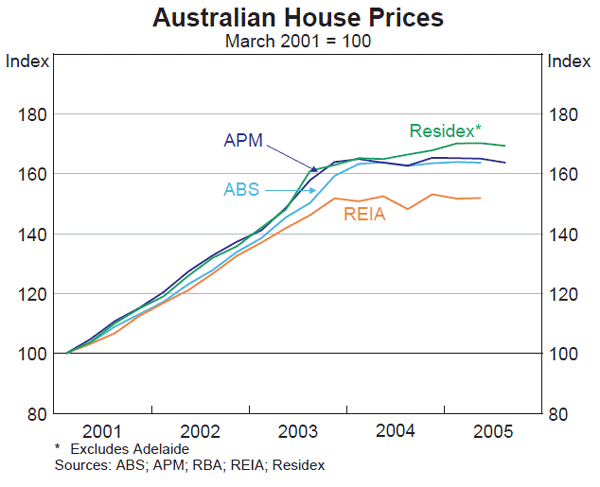
| APM | REIA | Residex | ||||||
|---|---|---|---|---|---|---|---|---|
| Sep qtr 2005 |
Year to Sep qtr 2005 |
Sep qtr 2005 |
Year to Sep qtr 2005 |
Sep qtr 2005 |
Year to Sep qtr 2005 |
|||
| Sydney | −1.5 | −4.3 | .. | .. | 0.3 | −2.0 | ||
| Melbourne | −1.0 | 1.7 | 0.0 | 2.4 | −1.8 | −0.2 | ||
| Brisbane | −0.9 | −0.3 | .. | .. | −0.8 | 3.2 | ||
| Adelaide | 0.0 | 3.9 | −1.1 | 3.8 | .. | .. | ||
| Perth | 2.4 | 16.2 | 4.4 | 20.8 | 0.8 | 11.8 | ||
| Canberra | −2.0 | −0.3 | .. | .. | −1.6 | −1.1 | ||
| Australia(a) | −0.8 | 0.5 | .. | .. | −0.5 | 1.7 | ||
|
(a) Residex data exclude Adelaide. Sources: APM; REIA and state REIs; Residex |
||||||||
Recent auctions data are consistent with conditions in the housing market remaining subdued. Over the past few months, clearance rates in Sydney and Melbourne have fluctuated around levels considerably lower than their averages over the past five years, and auction volumes remain low. However, auctions account for a relatively small share of total properties sold.
Business sector
Conditions in the business sector remain favourable, as indicated by strong profits and solid investment activity. Nonetheless, surveys have tended to show some deterioration in business conditions compared with those last year, especially in the manufacturing sector. The NAB survey of the non-farm sector indicated that business conditions softened modestly in the September quarter, although they remained well above long-run average levels (Graph 33). Capacity utilisation eased slightly in the quarter but also remained at high levels, particularly in the mining and infrastructure sectors (Graph 34). Firms cited the lack of availability of suitable labour as a significant constraint on increasing their output. Other surveys of the non-farm economy provide a more mixed picture of developments. The ACCI Survey of Investor Confidence reported that actual and expected business conditions picked up in the September quarter, while the Sensis survey of small and medium-sized businesses suggested a modest weakening in conditions.
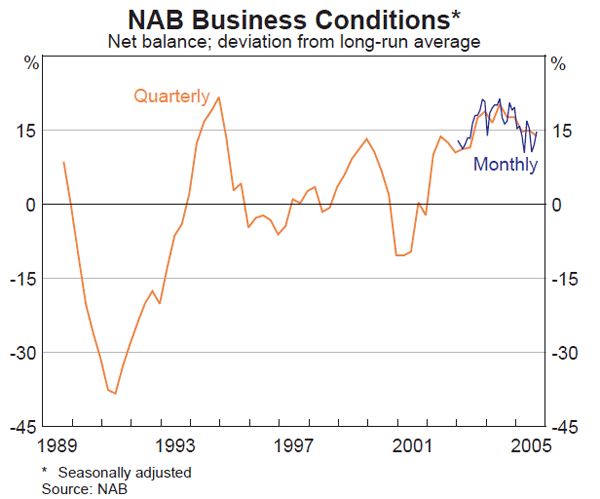
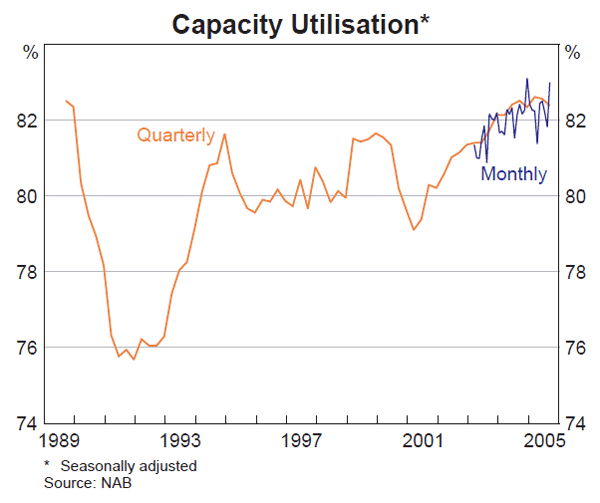
The manufacturing sector has for some time reported a weaker business climate. The ACCI-Westpac survey indicated that business conditions deteriorated in the September quarter, although they remained a little above long-run average levels. The latest AIG quarterly survey indicated a more subdued level of activity in the manufacturing sector, with the AIG Performance of Manufacturing Index indicating that weak conditions continued into October.
Prospects for the farm sector continue to brighten. Recent forecasts suggest the national wheat crop will be slightly above its average of the past five years. The earlier downside risks to the outlook, owing to late planting and dry conditions, have diminished with recent rains in major growing areas. While these rains have improved the outlook for grain production, they are yet to significantly alleviate the shortage of stored water, and many parts of eastern Australia remain drought-declared.
The strong upswing in business investment seen in recent years continued in the first half of 2005, with real business investment increasing by 15 per cent over the year to the June quarter, underpinned by high capacity utilisation, healthy profits and falling prices for imported capital goods (Graph 35). Business investment growth in the June quarter was driven by spending on both machinery & equipment and non-residential building. Growth in capital spending in recent quarters has been particularly rapid in mining – consistent with surging profits due to the high level of commodity prices – but there has also been broad-based strength in other sectors.
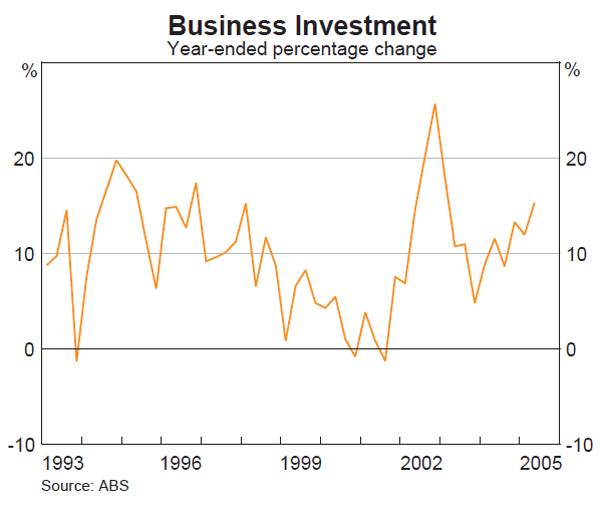
Conditions remain supportive of further growth in business investment, with sound prospects for the domestic and world economies and a favourable funding environment. The latest capital expenditure (Capex) survey suggests a solid increase in firms' intentions for real machinery & equipment investment in 2005/06, reflecting a pick-up in spending in the transport & storage, finance & insurance, and manufacturing sectors. The Rabobank survey suggests that investment intentions for farm equipment (which are not covered in the Capex survey) have recovered to their pre-drought levels.
Forward-looking indicators of non-residential construction also suggest a high level of activity in coming quarters (Graph 36). Even though the level of engineering construction activity has more than doubled over the past four years, activity is expected to be supported by the near-record amount of this work yet to be done. The outlook for the non-residential building component is not as strong, with the average volume of work approved so far in 2005 around the current level of activity.
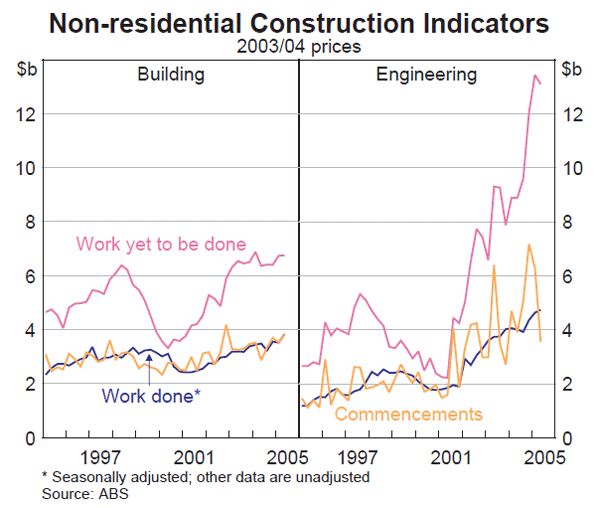
Corporate profitability has strengthened further, with a strong June quarter outcome underpinning a 10.4 per cent increase in the gross operating surplus of private non-financial corporations over the year. This result primarily reflected a large increase in the profits of mining companies, which have benefited from solid world demand and the large increase in commodity prices (Graph 37). Profit growth has been substantially weaker in the non-mining non-financial sectors, and as a share of GDP these profits have declined over the past year, although from a high level. Businesses across a range of sectors have recently noted that tight labour market conditions and high fuel and raw material prices have begun to affect their profit margins.
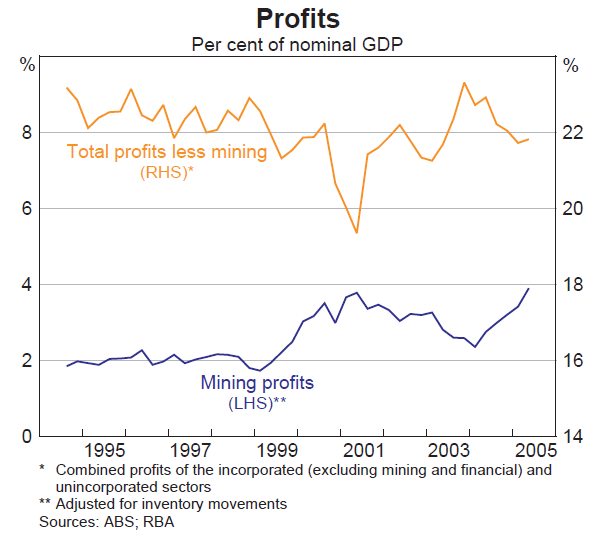
Businesses continue to have ample access to financing, with both external and internal funding as a share of GDP well above their historical averages. Business credit increased by an annualised rate of 15.5 per cent in the six months to September.
Labour market
The labour market remained strong in the September quarter, despite a decline in employment in the month of September for the first time in over a year. In four-quarter-ended terms total employment grew by 3.6 per cent, with part-time employment increasing by 4.7 per cent and full-time employment by 3.2 per cent (Graph 38). The participation rate was unchanged from the June quarter, at 64.6 per cent, while the unemployment rate fell to 5.0 per cent in the quarter, although it ticked up to 5.1 per cent in the month of September.
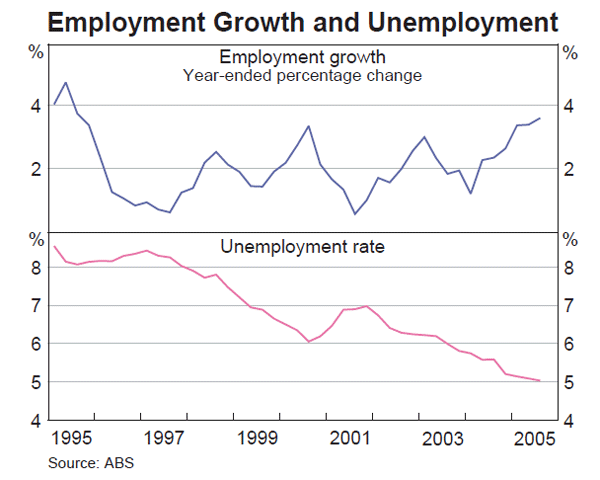
Most industries experienced sizeable employment gains over the year to the September quarter, with strong contributions to growth from the retail, construction and business services sectors. Only three industries experienced falling employment: manufacturing, personal & other services, and wholesale trade.
In the September quarter, employment increased in all states except Victoria (Table 8). The Western Australian labour market posted the strongest performance, with annual employment growth around 7 per cent and an unemployment rate below 4½ per cent. While New South Wales recorded the weakest year-ended growth in employment, the pace has been picking up and is now well above its long-term average. While the performance of the Western Australian labour market has clearly been stronger than other states, the range of unemployment rates across the states has tended to narrow over recent quarters, pointing to some convergence in state labour market conditions.
| Employment growth | Unemployment rate | ||||
|---|---|---|---|---|---|
| September qtr 2005 |
Year to September qtr 2005 |
September qtr 2004 |
September qtr 2005 |
||
| NSW | 0.4 | 2.5 | 5.4 | 5.0 | |
| Victoria | −0.2 | 2.6 | 6.0 | 5.4 | |
| Queensland | 1.0 | 5.2 | 5.5 | 5.0 | |
| WA | 1.3 | 7.1 | 4.9 | 4.4 | |
| SA | 0.3 | 2.9 | 6.1 | 4.8 | |
| Tasmania | 1.1 | 3.1 | 6.5 | 5.9 | |
| Australia | 0.5 | 3.6 | 5.6 | 5.0 | |
|
Source: ABS |
|||||
While forward-looking indicators of labour demand moderated in the September quarter, they generally remained at high levels (Graph 39). The ACCI-Westpac and NAB measures of firms' hiring intentions have been above long-run average levels for some time. The ABS measure of vacancies fell by 3.9 per cent in the three months to August, but as a proportion of the labour force remained around 25 per cent higher than its decade average. The pace of year-ended growth in the ANZ internet-based job advertisements series eased in the quarter from its recent high level, while the number of print-based vacancies continued to fall. Liaison reports indicate that skill shortages remain acute across a broad range of occupations.
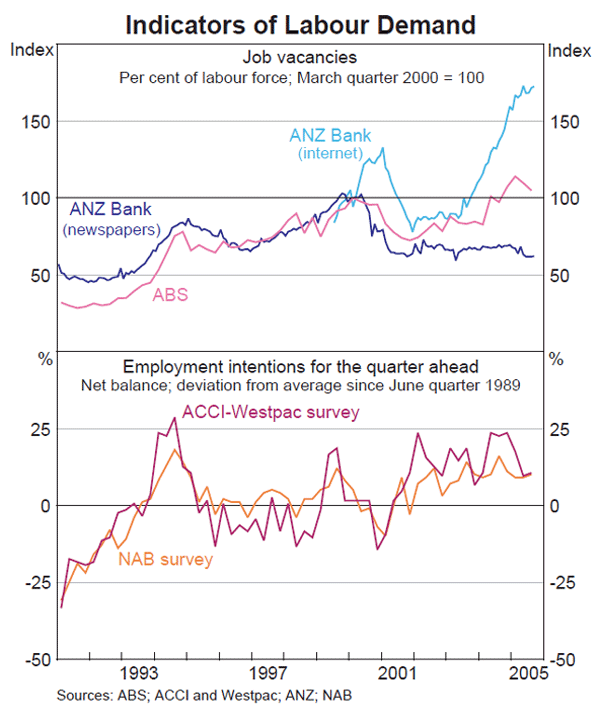
Balance of Payments
The trade deficit has narrowed recently, to around 2 per cent of GDP in the June quarter (Graph 40). More recent data suggest the trade deficit was broadly unchanged in the September quarter. The narrowing in the first half of 2005 was mainly driven by the sharply higher terms of trade, but there were also some tentative signs of a stronger contribution from volumes. Growth in import volumes has eased in line with the moderation in domestic demand growth, while export volumes have been picking up gradually, driven by the resource and manufactured components. The net income deficit narrowed in the first half of 2005. It was nonetheless much higher than a year or so earlier, largely because of the boost from strong profits of mining companies with foreign ownership. Reflecting these developments, the current account deficit fell significantly in the June quarter, to an initial estimate of 5.7 per cent of GDP, down from a peak of 7.2 per cent of GDP at the end of 2004.
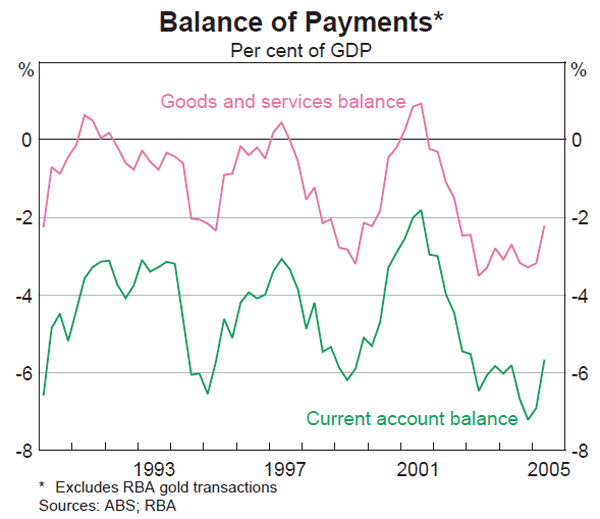
Exports
Export earnings increased sharply over the year to the September quarter, largely reflecting rapid growth in export prices, especially for resource commodities (Graph 41). Resource export earnings increased by almost 40 per cent over the year to the June quarter, buoyed in particular by rising prices for Australia's two largest commodity exports, coal and iron ore. There was also an 8½ per cent increase in volumes over this period, following expansions in production capacity. Resource export earnings continued to increase in the September quarter, though this appears to reflect further price rises. Export volumes are likely to have been held back in the quarter by some temporary disruptions to port loading capacity and LNG production. The outlook for resource exports remains positive, with expansions in productive and infrastructure capacity underway.
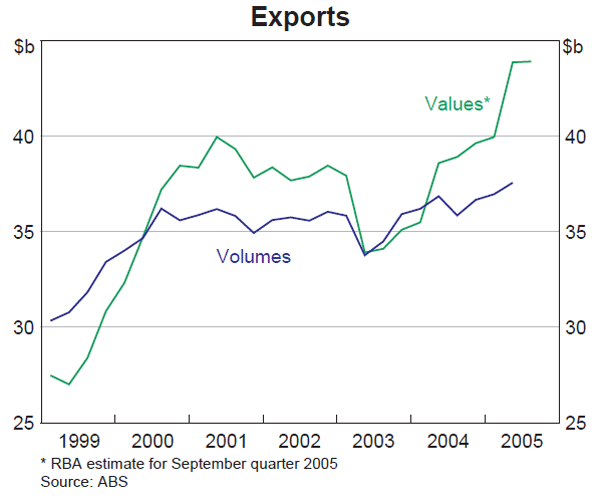
The volume of rural exports fell in 2004/05 overall, as the smaller winter crop led to a large decline in cereals exports. There was a modest recovery in exports in the June quarter, with volumes increasing by 3 per cent, but there was no further improvement in the September quarter. The more favourable weather conditions in recent months have resulted in a better outlook for crop exports, although at least initially, they are likely to encourage herd rebuilding and thereby reduce meat exports. Overall, the Australian Bureau of Agricultural and Resource Economics (ABARE) forecasts a fall in total rural exports in 2005/06. Beef exports could also be affected from early 2006 if the lifting of BSE-related bans increases competition in the Japanese market from US beef.
The volume of manufactured exports increased strongly in the June quarter, following moderate growth over the previous year. Although lumpy one-off items accounted for some of this strength, there also appears to have been some underlying growth. Monthly data suggest that both manufactured export earnings and volumes fell slightly in the September quarter, as these lumpy exports unwound. Although trading partner growth remains firm, which would suggest a positive outlook for manufactured exports, liaison with firms continues to highlight difficulty in maintaining international competitiveness.
After falling in the June quarter, the volume of services exports appears to have stabilised in the September quarter, notwithstanding the pick-up in short-term visitor arrivals. Services exports remain slightly below their 2001 level; for travel services, this has at least partly reflected declining average visitor expenditure, as visitor arrivals have been well above 2001 levels for some time. Looking forward, continued favourable growth among Australia's trading partners should support demand for exports of both travel-related and other services.
Imports
Growth in import volumes has eased during 2005 from the rapid rates seen in 2004. Import volumes grew at an average quarterly rate of 2.2 per cent in the first half of 2005, down from an average of 3.3 per cent per quarter in 2004 (Graph 42). This slowing is consistent with the easing in growth of domestic demand over the past year and a half and the relative stability of the exchange rate over this period, after a period of significant appreciation, and was evident in imports of all major categories. There appears to have been a further slowing in the September quarter, with volumes estimated to have fallen slightly.
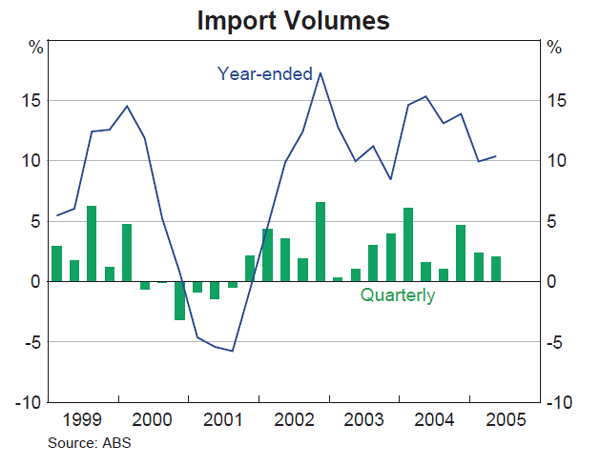
Net income
The net income deficit (NID) increased sharply over the second half of 2004, mainly because of a marked increase in earnings on foreign direct investment in Australia, in line with the exceptionally strong growth in mining profits. It has since narrowed over the first half of 2005, to be $7.6 billion or 3.4 per cent of GDP in the June quarter, but this was still around 19 per cent higher than a year earlier (Graph 43). A large proportion of the equity earnings that drove these fluctuations were retained by Australia-based companies and did not result in actual payment flows. However, the standard balance of payments methodology includes retained earnings on direct equity investments in the NID, as well as distributed income from this and other forms of foreign investment. Excluding undistributed and reinvested earnings, the NID has been broadly flat at around 3 per cent of GDP since early 2003 (see ‘Box C: Australia's Net Income Deficit’, May 2005 Statement on Monetary Policy).
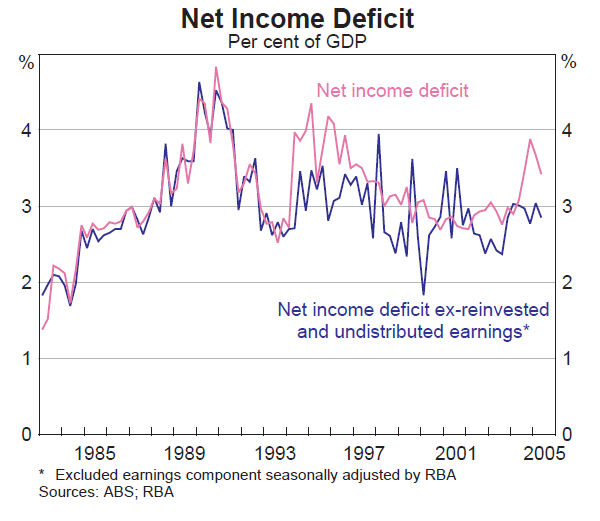
Commodity prices and the terms of trade
Favourable global economic conditions and higher contract prices for Australia's coal and iron ore exports contributed to a 30 per cent increase in the RBA index of commodity prices (ICP) over the year to October in SDR terms (Table 9). The series is now at its highest level since it began in 1982. The index rose by 2.7 per cent over the three months to October, reflecting solid increases in base metals and rural commodity prices. In Australian dollar terms, commodity prices rose by 2.1 per cent over the three months to October, and were up by 23 per cent over the year.
| Three months to October 2005 |
Year to October 2005 |
|
|---|---|---|
| RBA Index | 2.7 | 29.6 |
| Rural | 4.7 | 6.4 |
| – Wheat | 14.8 | 10.6 |
| – Beef & veal | 0.8 | −2.1 |
| – Wool | −7.6 | −5.0 |
| Base metals | 6.0 | 12.3 |
| – Aluminium | 8.8 | 8.0 |
| – Copper | 12.8 | 37.8 |
| – Nickel | −14.5 | −11.6 |
| Other resources | 1.1 | 46.9 |
| – Coking coal(a) | 7.9 | 104.4 |
| – Steaming coal(a) | 1.6 | 20.8 |
| – Iron ore(a) | −4.0 | 66.7 |
| – Gold | 11.0 | 14.1 |
| Memo item: | ||
| Oil in US$(b) | 6.6 | 19.7 |
|
(a) Latest available data are for September. Sources: ABS; AWB; AWEX; Bloomberg; Meat and Livestock Australia; RBA |
||
As noted in previous Statements, contracts for the export of iron ore and hard coking coal were negotiated with US dollar price increases of about 70 per cent and 120 per cent respectively, effective from the start of April, with a more modest increase in steaming coal prices. Data to September indicate that essentially all of the increase in iron ore and steaming coal contract prices has now passed through to export prices, but not all of the rise in coking coal contract prices has been reflected in the average price received by exporters. The latter is reportedly partly due to some delay in fulfilling obligations under the previous year's contracts, so a further small increase in coking coal export prices is expected in the near term.
The RBA index of base metals prices increased by 6 per cent in SDR terms over the three months to October, reaching its highest level since 1989. Copper and aluminium prices showed particular strength, supported by strong global demand and strikes at some large overseas copper mines. The gold price also rose strongly over this period, primarily reflecting market concerns about US inflation, although market commentary suggested that concern about terrorist activity also contributed.
Average rural commodity prices increased by around 5 per cent in SDR terms over the three months to October, largely owing to solid growth in the price of wheat, as forecasts of global supply in 2005/06 were pared back. Sugar and cotton prices also rose in response to stronger demand for ethanol and cotton textiles, as high oil prices have been boosting the cost of petrol and petroleum-based synthetic fibres that compete with these products.
The recent large increases in iron ore and coal export prices underpinned a 5.8 per cent increase in the terms of trade in the June quarter (Graph 44). This took them to their highest level since 1974, having increased by around 26 per cent over the past three years. Given the rise in commodity prices since June, the terms of trade are likely to have experienced a further modest rise in the September quarter.
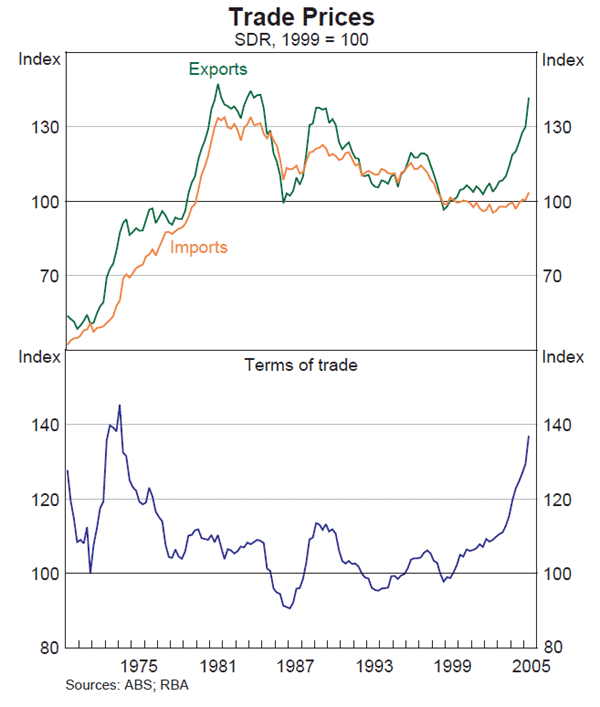
Real exchange rate
In real trade-weighted terms, the Australian dollar was around 13 per cent above its post-float average in early November, and has been broadly stable around this level since early 2004 (Graph 45). At its current level, the exchange rate is restraining activity in some trade-exposed businesses, particularly in the manufacturing sector. However, for the economy as a whole, the benefits from the increased terms of trade are offsetting the contractionary effects of the current level of the exchange rate.
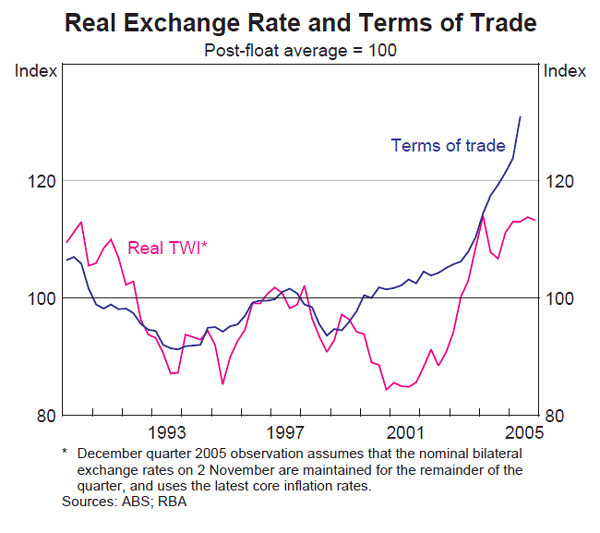
Domestic Financial Markets and Conditions
Interest rates and equity prices
Money and bond yields
Conditions in domestic money and bond markets have followed those in US markets over recent months as investors have continued to assess the outlook for domestic growth and inflation against the backdrop of higher oil prices and other overseas developments.
Short-term interest rates fell through most of August, particularly late in the month on news of Hurricane Katrina (Graph 46). By early September, these rates indicated that markets were pricing in some chance of easier monetary policy in the first half of 2006. The falls, however, were mainly in response to a sharp move lower in US short-term yields at the time and were quickly unwound as US yields began their retracement in early September. Local short-term yields continued to edge a little higher over subsequent weeks on the back of generally positive economic news and expectations that monetary policy may need to be tightened at some point, to counter a build-up of inflationary pressures.
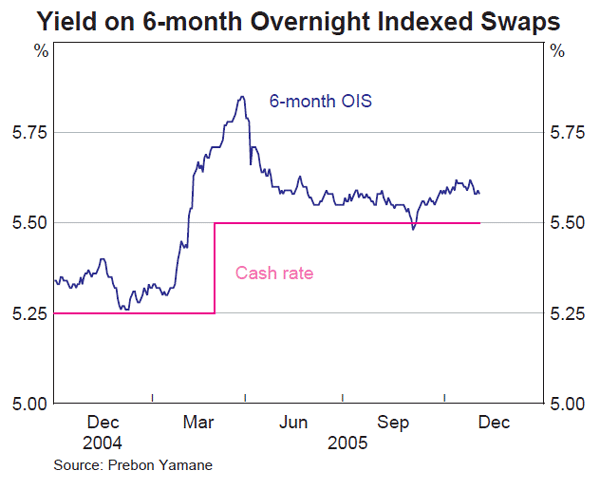
Bond yields have moved in a similar but more pronounced fashion to short-term rates (Graph 47). From mid August to early September, long-term bond yields fell by around 30 basis points, mainly on concerns that rising energy costs may slow the pace of global, and hence domestic, growth. Concerns about the broad consequences of the hurricanes around the Gulf of Mexico added to the falls. Yields subsequently rose as these concerns diminished and domestic data releases generally maintained a healthy tone. Yields on 10-year bonds are currently around 5.5 per cent, a little higher than at the time of the last Statement. Yields on inflation-linked bonds fell to their lowest recorded level, of 2.3 per cent, in late August and at 2.5 per cent are still low by historical standards.
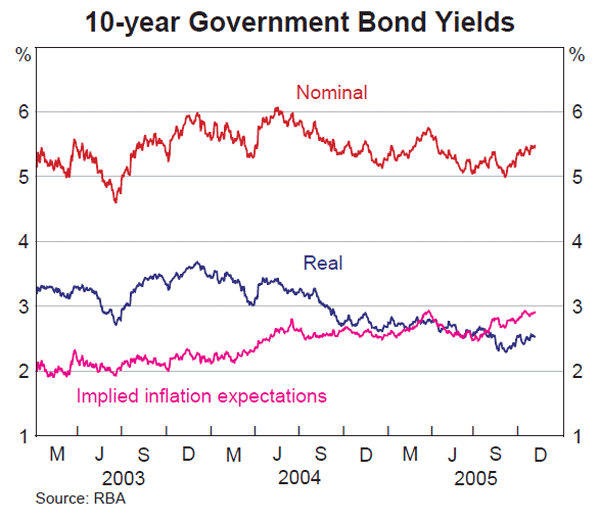
With local bond yields moving broadly in line with those in the US, the spread between the yields on Australian and US 10-year bonds has generally remained a bit below 100 basis points over the past few months. At these levels, the spread remains well below its average for the past few years (Graph 48).
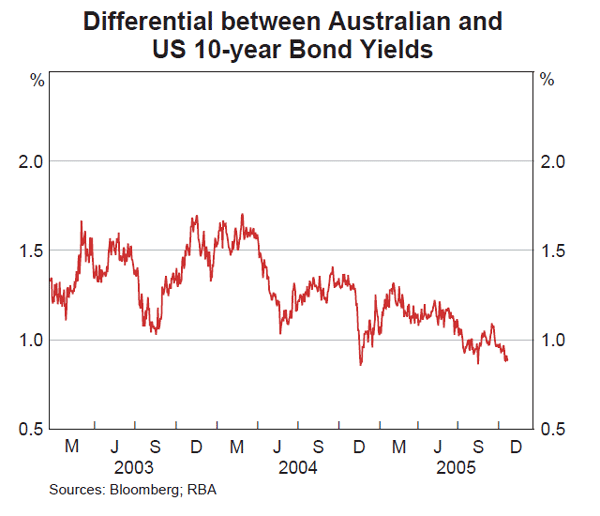
Despite the net rise in bond yields since the time of the previous Statement, they are still low by historical standards and the yield curve remains unusually flat (Graph 49). As mentioned in previous Statements, it is difficult to draw any firm conclusions about the stance of monetary policy from the current level of bond yields because of the strong influence of US bond yields, which are unusually low. A clearer measure of the markets' expectations for the cash rate over the next year or so can be gauged from overnight indexed swaps.
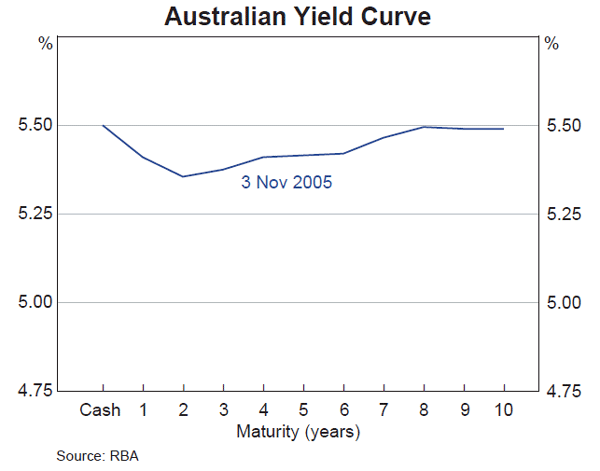
Spreads on corporate bonds remain at very low levels, suggesting there has been little change in market participants' perceptions of corporate credit risk. Spreads to swap rates on AAA-rated conventional bonds have tightened a little over recent months, and are currently around 10 basis points lower than a year ago (Graph 50). AAA-rated tranches of residential mortgage-backed securities (RMBS) are being issued at near-record low spreads, with demand from domestic and offshore investors remaining strong. Recent issues have come onto the market at spreads of around 15–20 basis points, compared with around 30–35 basis points a couple of years ago.
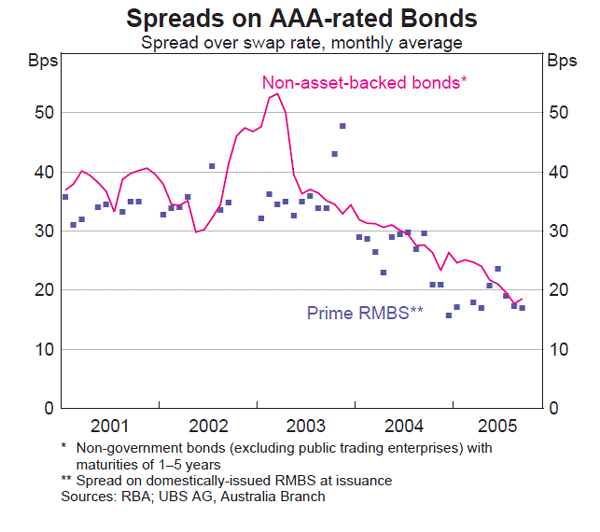
There has also been little movement in credit risk perceptions of lower-rated corporate borrowers over recent months, despite the rise in corporate spreads in the US following several prominent companies moving into bankruptcy. Spreads between corporate bonds and swap rates, and the premia on credit default swaps, have remained near historical lows (Graph 51). One factor explaining these tight spreads is the strength in demand for Australian corporate debt coming from offshore investors. In the first half of 2005, these investors increased their holdings of domestic non-government debt by $9 billion to $38 billion, which is 22 per cent of total outstandings. In contrast, over the past year or so, domestic bonds fund managers have shifted their allocations towards government bonds and cash. Box B discusses some recent trends in the portfolio decisions of these fund managers.
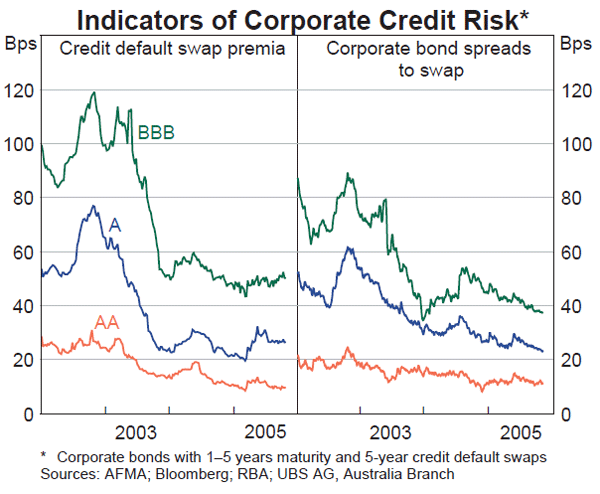
Intermediaries' interest rates
Most intermediaries' variable indicator lending rates have remained constant since the time of the previous Statement. However, competitive pressures remain: a few mortgage originators have reduced the indicator rates on their standard and basic variable-rate housing loans by up to 15 basis points in recent months; and discounts to indicator rates on housing loans appear to have become larger and more widespread. Although variable indicator rates on housing loans were unchanged over 2004, the average actual rate paid on new housing loans is estimated to have declined by around 15 basis points over that period (Graph 52). The discounts advertised by lenders in recent months suggest that this widening of the spread between indicator and actual rates has continued in 2005.
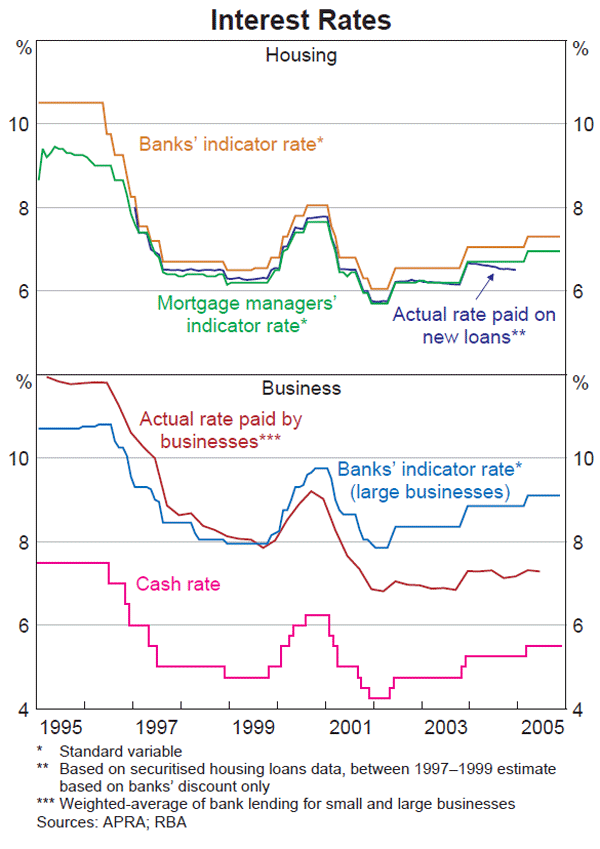
Businesses have also benefited from increased competition among lenders. Since 2002, the average interest rate paid by businesses on variable-rate loans has increased by around 50 basis points compared with an increase in the cash rate of 125 basis points. As a result, the average business interest rate has been below its decade average for several years (Graph 52). The relatively low level of business interest rates is consistent with the relatively low spreads on corporate bonds.
Interest rates on fixed-rate housing loans have fallen in the past couple of months, following a period of six months in which they were fairly stable. On average, the major banks' 3-year rate, the most popular term for fixed-rate loans, has fallen by 30 basis points, to 6.55 per cent (Graph 53 and Table 10). These moves appear to be in response to the decline in funding costs that occurred earlier in the year and reduced demand for fixed-rate loans. From June to August, the latest month for which there are data, a little under 10 per cent of new owner-occupier housing loans were taken out at fixed rates, down from a peak of nearly 15 per cent in March this year. More recently, lenders' funding costs for fixed-rate loans have increased in line with the rise in bond yields. As is usual, small business fixed rates have followed these movements fairly closely, rising by 30 basis points since the end of August, to be at their highest levels since early 2005.
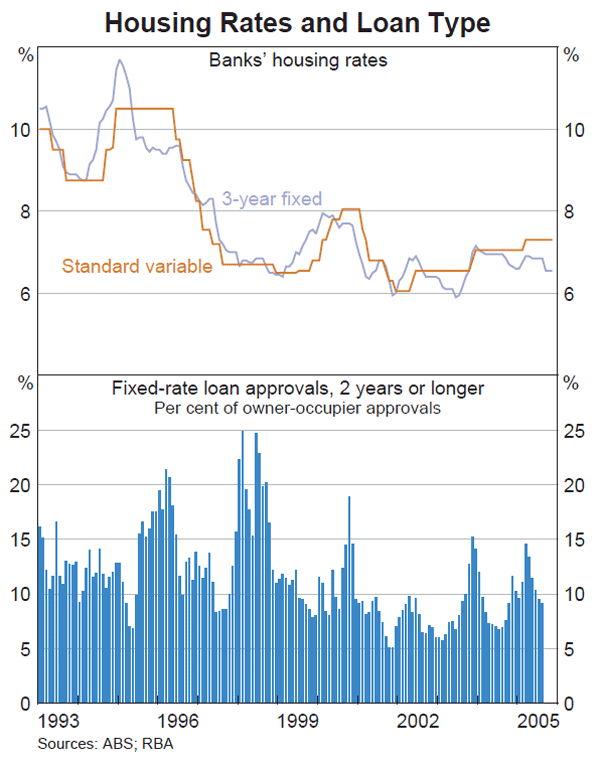
| Variable rates – household | |
|---|---|
| Housing: | |
| – Major banks' standard variable | 7.30 |
| – Major banks' basic variable | 6.75 |
| – Mortgage managers' standard variable | 6.95 |
| – Mortgage managers' basic variable | 6.35 |
| Other household: | |
| – Residential security | 7.45 |
| – Credit cards | 16.75 |
| Variable rates – small business | |
| Residential security: | |
| – Overdraft | 8.20 |
| – Term loan | 7.50 |
| Other security: | |
| – Overdraft | 9.10 |
| – Term loan | 8.10 |
| Variable rates – large business | |
| – Overdraft | 9.10 |
| Fixed rates (3 years) | |
| – Housing | 6.55 |
| – Small business | 7.50 |
| – Swap rate | 5.85 |
|
Source: RBA |
|
Equity prices
After reaching successive record highs in August and September, domestic share prices fell sharply in the first part of October. The ASX 200 has recorded a net decline of 5 per cent since its peak on 29 September, leaving the sharemarket a little higher than at the time of the previous Statement (Graph 54). The net fall in the ASX 200 since late September has been sharper than that in overseas equity markets, in large part because the share prices of resource companies, which have a relatively large weight in the Australian index, have fallen by around 8 per cent. Nonetheless, resource companies' share prices are still more than 30 per cent higher than at the beginning of the year (Graph 55).
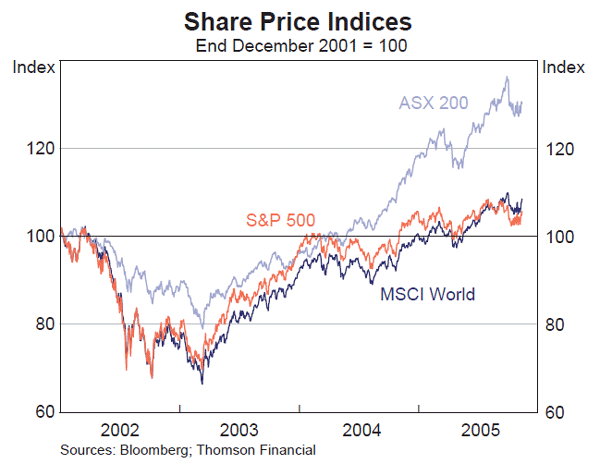
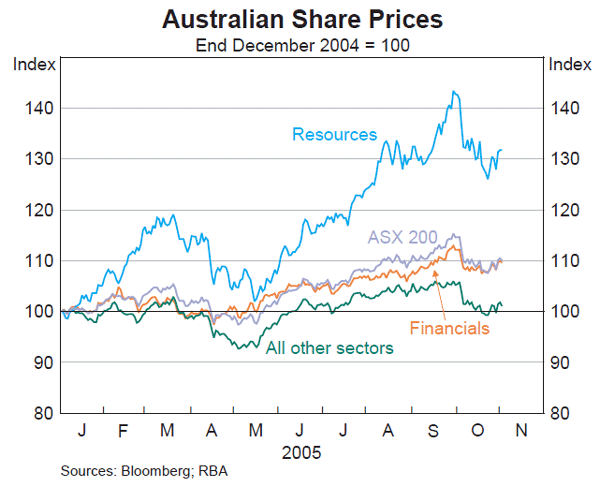
The Australian sharemarket as a whole is around 10 per cent higher than at the beginning of the year and 65 per cent higher than its low in March 2003. Broadly speaking, these price increases have been well supported by increases in company earnings: the market's current valuation, as measured by the aggregate P/E ratio based on historical earnings, is a bit below its average for the past decade, and around its average for much longer periods of time. The aggregate P/E ratio for global equity markets (excluding Australia) is well below its average for the past decade. This reflects a correction to the run-up in global sharemarkets in the second half of the 90s, at a time when earnings per share were quite flat (Graph 56). In short, the convergence of Australian and global P/E ratios largely reflects a downward correction in overseas markets over the past five years rather than the Australian market having become overly expensive.
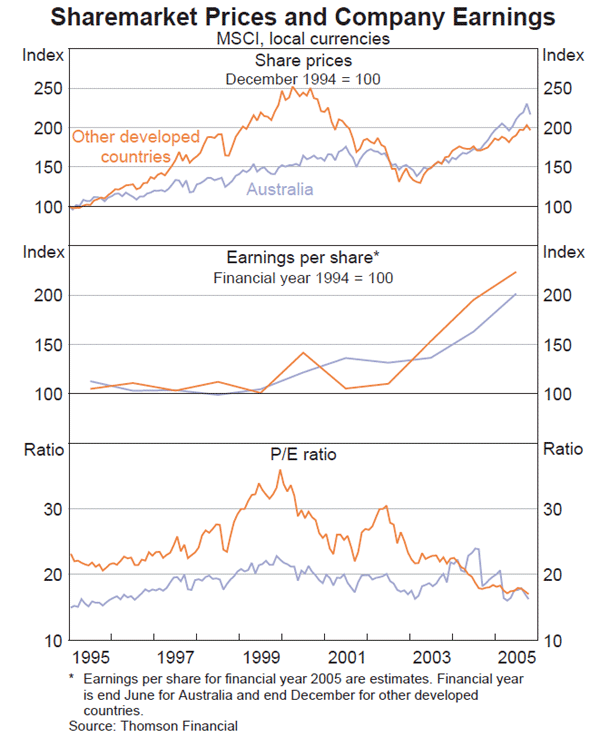
The forward P/E ratio – which is based on analysts' earnings estimates for the next 12 months – and the dividend yield are also around their 10-year averages.
Financing activity
Intermediated financing
Total credit growth has remained in a relatively tight range since early 2004, albeit with some tentative evidence of slowing in recent months, and stood at an annualised rate of 13.2 per cent in the six months to September (Table 11 and Graph 57). The gradual moderation in household credit growth over the past 18 months has been offset by a tendency towards stronger growth in business credit.
| Six-month-annualised | Year ended September 2005 |
||||
|---|---|---|---|---|---|
| September 2004 | March 2005 | September 2005 | |||
| Total credit | 14.0 | 13.3 | 13.2 | 13.3 | |
| Household | 15.7 | 14.8 | 11.9 | 13.4 | |
| – Housing | 16.7 | 14.9 | 12.1 | 13.5 | |
| – Personal | 9.7 | 14.3 | 10.7 | 12.5 | |
| Business | 11.3 | 10.8 | 15.5 | 13.1 | |
| Broad money | 6.4 | 10.3 | 9.3 | 9.8 | |
|
Source: RBA |
|||||
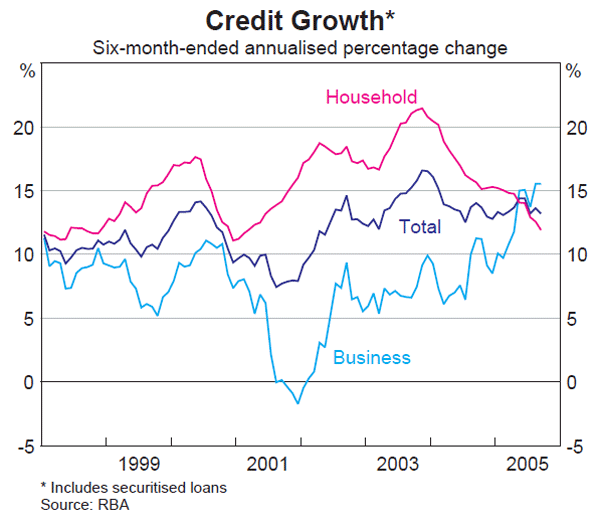
Household credit grew at an annualised rate of 11.9 per cent in the six months to September, below the average growth rate seen over the past decade and almost 10 percentage points lower than the peak rate at the end of 2003. While this moderation largely reflected the softening in housing credit growth, especially in lending to investors, growth in personal credit has also slowed from the high rates recorded around the turn of the year.
Within personal credit, growth in margin lending for the purchase of shares and managed funds moderated a little in the September quarter but was still strong, consistent with the strength in the share market over that period (Graph 58). Growth over the year, at 30 per cent, remained around the fastest annual pace since early 2002. Against the trend of the past year, growth in margin debt in the September quarter was mainly due to an increase in the average loan size, to $126,000, with the number of borrowers remaining broadly unchanged.
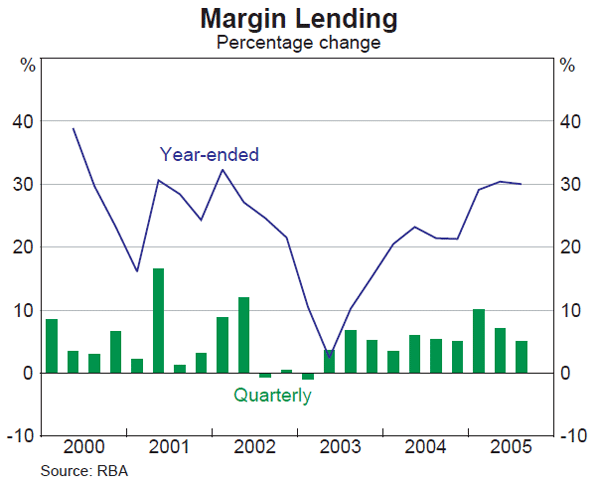
The majority of new margin loans taken out in the September quarter were at variable interest rates, with the fixed-rate share falling to a more normal level of 20 per cent from 60 per cent in the June quarter. (The higher share of fixed-rate loans in the June quarter was mainly due to investors pre-paying their interest to bring forward tax deductions.) The average frequency of margin calls in the September quarter was little changed from its historically low level, reflecting the absence of significant price falls during the quarter and relatively low gearing levels. The latter, together with the relatively low percentage of credit limits being used, suggest that, on average, investors are taking a more conservative approach to their margin borrowing than in the past.
Growth in business credit has remained strong, at an annualised rate of 15.5 per cent in the six months to September. Contributing to this has been the strength in syndicated loan approvals, which totalled $37 billion in the period, compared with $28 billion in the previous six months (Graph 59). By value, around a third of the syndicated loan approvals in the six months to September were used for merger and acquisition activities and another third were used for general corporate purposes.
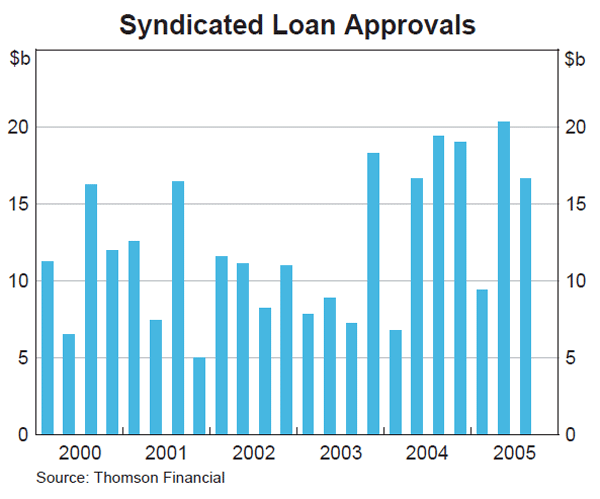
On the liability side of intermediaries' balance sheets, the growth rate of broad money has moderated a little in recent months, to an annualised rate of 9.3 per cent over the six months to September. The continued positive gap between the rates of growth of total credit and broad money predominantly reflects intermediaries' increased reliance on funding sources not included in broad money, such as bonds and asset-backed securities.
Non-intermediated financing
Following record issuance of $50 billion by Australian non-government entities in the June quarter, gross bond issuance in the September quarter was more subdued, at just under $40 billion (Table 12). This moderation was mainly due to a decline in financial and non-financial corporates' issuance into offshore markets. Issuance into the domestic market by these entities, as well as by asset-backed vehicles, remained strong, with almost $20 billion raised in the latest quarter. The recent strength of issuance by non-residents into the domestic market has also been maintained, with $9 billion raised in the September quarter. A noteworthy trend within this has been an increased number of large deals ($1 billion and over) being offered by single issuers, mainly large banks, which have been comfortably absorbed by the domestic market.
| 2003 | 2004 | 2005 | |||
|---|---|---|---|---|---|
| March quarter |
June quarter |
September quarter |
|||
| Bond issues by Australian entities | |||||
| Onshore | |||||
| Financial institutions | 9.7 | 14.3 | 6.1 | 3.7 | 7.0 |
| Non-financial corporates | 5.8 | 8.0 | 1.1 | 2.3 | 3.9 |
| Asset-backed | 20.6 | 25.0 | 8.6 | 10.6 | 8.0 |
| Total | 36.1 | 47.3 | 15.8 | 16.5 | 18.9 |
| Offshore | |||||
| Financial institutions | 50.9 | 64.7 | 14.9 | 16.8 | 11.6 |
| Non-financial corporates | 15.3 | 13.6 | 2.2 | 8.6 | 0.9 |
| Asset-backed | 24.3 | 29.8 | 7.1 | 7.7 | 7.2 |
| Total | 90.5 | 108.0 | 24.2 | 33.1 | 19.7 |
| Total | 126.7 | 155.3 | 40.0 | 49.6 | 38.5 |
| A$ bond issues by non-resident entities | |||||
| Onshore | 7.1 | 21.3 | 6.1 | 3.4 | 9.0 |
| Offshore | 24.7 | 21.5 | 4.8 | 2.9 | 2.7 |
| Total | 31.8 | 42.9 | 10.9 | 6.2 | 11.7 |
|
Source: RBA |
|||||
Net equity raisings for the September quarter totalled around $4 billion, slightly below the post-2001 average (Graph 60). The bulk of raisings were by financials companies. IPOs were dominated by firms within the real estate or diversified financials industries. Other equity raisings were dominated by dividend reinvestment plans, again mainly among financials companies.
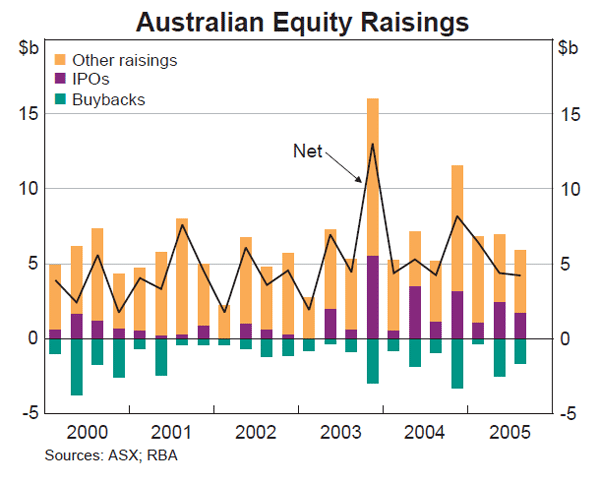
Despite the strength of the sharemarket this year, non-financials' equity raisings have been modest. But, as noted in the chapter on ‘Domestic Economic Conditions’, these businesses remain well funded in total.
Box B: Australian Fund Managers' Bond Portfolios
Fund managers are one of the main categories of investors in the Australian bond market. These institutions hold roughly a quarter of bonds outstanding in Australia, that is, around $70 billion. Insurance companies and offshore investors each hold a similar share, while banks and other deposit-taking institutions hold a further sixth of outstandings. This box examines how fund managers have allocated their bond portfolios over recent years.[1]
The composition of fund managers' domestic bond portfolios was relatively stable over the course of 2002 and 2003; there was a small increase in the allocation to non-government bonds – mainly at the expense of cash – and there was some switching between Commonwealth and state government debt. In early 2004 these institutions reduced their allocations to Commonwealth securities and switched to nongovernment bonds (in the face of strong demand from offshore institutions for Commonwealth securities) (Graph B1).
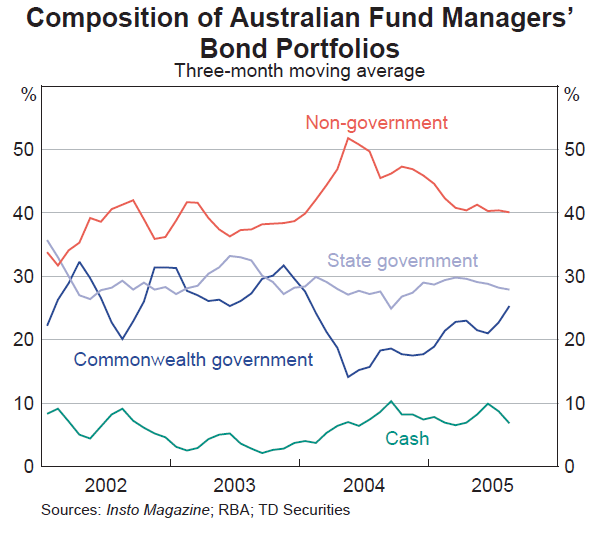
Over the past year, as spreads between non-government bonds and government bonds narrowed, fund managers have steadily rebalanced their portfolios towards Commonwealth Government bonds and away from non-government bonds. Growth in funds under management has meant that fund managers have still been net buyers of non-government bonds over this period, but to a lesser extent than banks and non-residents.
Consistent with this development, fund managers have also been progressively rebalancing their non-government portfolios towards bonds with higher credit ratings (Graph B2). During the second half of 2004, fund managers reduced their exposures to BBB-rated and sub-investment grade debt, and increased their exposure to A-rated debt. In 2005, they continued to reduce their exposure to BBB-rated and sub-investment grade debt, and switched out of A-rated debt and into AA-rated debt, as the relative pick-up on A-rated debt continued to decline. Over the whole period, AAA-rated bonds have typically comprised about half of bond managers' non-government bond portfolios. Residential mortgage-backed securities have likely accounted for the bulk of these bonds.
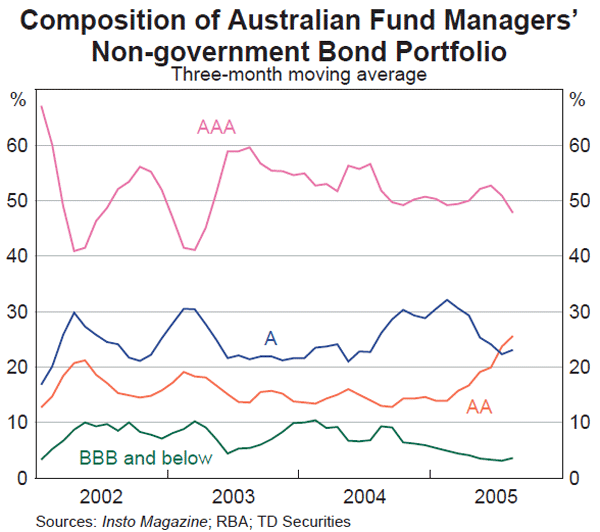
Market commentary has suggested that fund managers' decision to reduce the credit risk in their bond portfolios did not reflect concerns that default rates would increase noticeably in coming months – corporate earnings remain strong, debt levels are low, and upgrades continue to outpace downgrades. Instead, it appears that fund managers have taken the view that high levels of global liquidity have depressed spreads to levels that no longer adequately compensate investors for the risk that they are accepting, even if that risk is not very high.
In addition to credit risk, fund managers are concerned with interest rate risk – the risk that changes in interest rates will adversely affect the value of their bond holdings. From mid 2003 to mid 2005, fund managers reduced the duration of their bond portfolios relative to their benchmark (which in most cases is the UBS Composite Index) (Graph B3). This broadly coincided with the inversion of the Australian yield curve, and probably reflected a view amongst fund managers that longer-dated bonds were expensive given the likely stance of monetary policy over coming years. Since August, bond yields have risen (prices fallen) and fund managers have lengthened their duration.
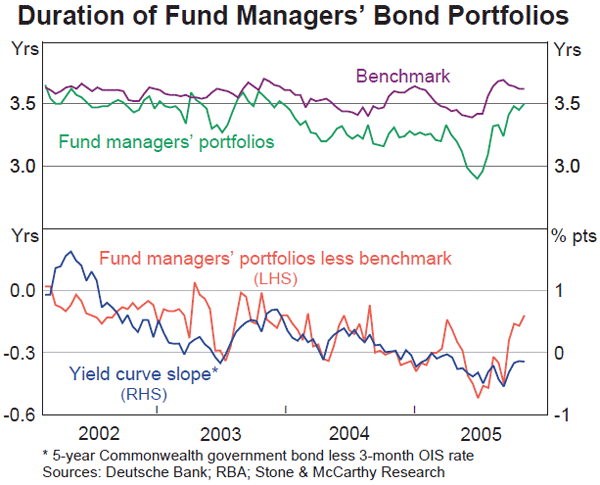
Inflation Trends and Prospects
Recent developments in inflation
The Consumer Price Index (CPI) rose by 0.9 per cent in the September quarter, to be 3.0 per cent higher over the year (Graph 61, Table 13). Based on a range of underlying inflation measures, the Bank's assessment is that underlying inflation was around 2½ per cent over the year to the September quarter. A significant factor explaining the difference between CPI and underlying inflation was the effect of petrol prices, which rose by 11.6 per cent in the September quarter and by almost 20 per cent over the year, reflecting movements in world oil prices. (See ‘Box C: Oil Usage in the Australian Economy’ for details of expenditure on oil by both households and businesses.)
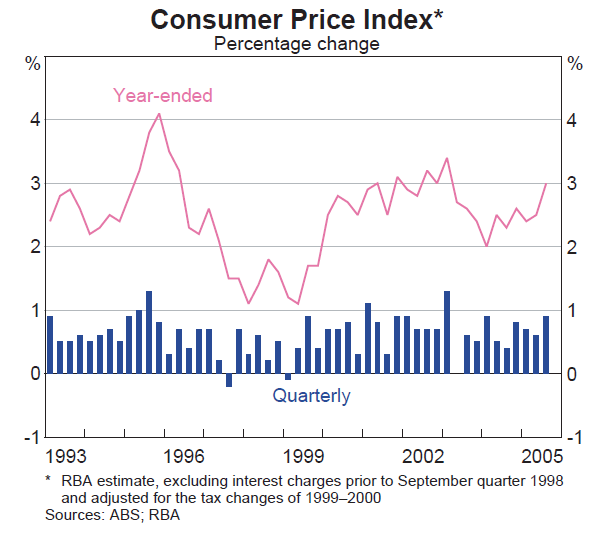
| Quarterly | Year-ended | ||||
|---|---|---|---|---|---|
| June quarter 2005 |
September quarter 2005 |
June quarter 2005 |
September quarter 2005 |
||
| CPI | 0.6 | 0.9 | 2.5 | 3.0 | |
| – Tradables | 0.8 | 1.2 | 1.3 | 2.6 | |
| – Tradables (ex food and petrol) | 0.3 | 0.1 | −0.1 | 0.2 | |
| – Non-tradables | 0.5 | 0.8 | 3.5 | 3.4 | |
| Underlying measures | |||||
| Weighted median(a) | 0.7 | 0.6 | 2.5 | 2.5 | |
| Trimmed mean(a) | 0.7 | 0.6 | 2.6 | 2.6 | |
| CPI ex volatile items(b) | 0.4 | 0.6 | 2.3 | 2.4 | |
|
(a) Based on the distribution of seasonally adjusted quarterly price changes. Sources: ABS; RBA |
|||||
Ongoing strength in house purchase costs also made a significant contribution to CPI inflation in the September quarter, as did price rises for domestic holiday travel & accommodation, and property rates & charges. These increases were offset to some extent by a seasonal fall in the price of pharmaceuticals and a fall in the price of a new component of the CPI – deposit & loan facilities – which appeared to be partly the result of the removal of state debits taxes. The introduction of the deposit & loan facilities price series, and a number of other changes to the CPI, are discussed in ‘Box D: The Introduction of the 15th Series Consumer Price Index’.
The gap between tradables and non-tradables price inflation has continued to narrow. The price of tradables rose by 1.2 per cent in the quarter, driven by increases in the prices of petrol and food. Excluding these items the increase in tradables prices was modest, but the year-ended rate became positive for the first time in nearly two years, as the disinflationary effects of the appreciation of the exchange rate in 2002 and 2003 have now largely passed (Graph 62). The price of non-tradables rose by 0.8 per cent in the quarter to be 3.4 per cent higher than a year ago; the year-ended rate has eased from the high rates prevailing in early 2004, mainly reflecting some moderation in the growth of housing costs.
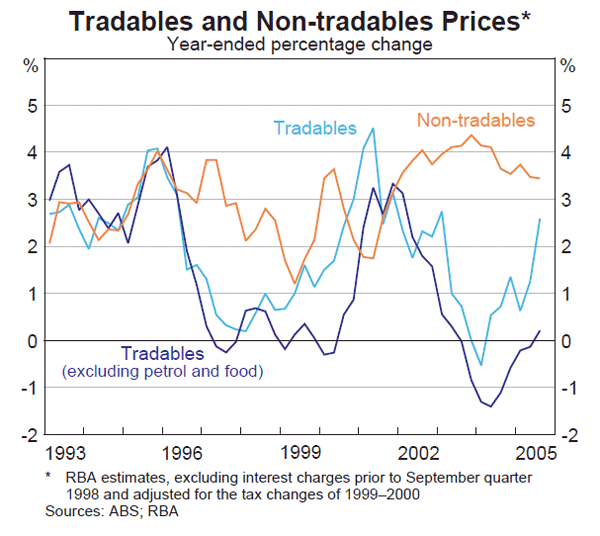
Producer prices
Producer price data indicate that upstream inflation pressures remained firm over the year to the September quarter (Graph 63, Table 14). The direct effects of high world oil prices continued to make a significant contribution to growth in producer prices, but even excluding these effects, there were sizeable increases in prices at all stages of production.
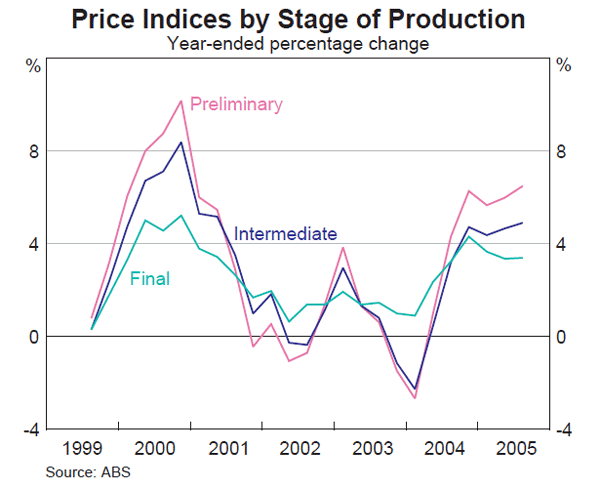
| September quarter 2005 |
Year to September quarter 2005 |
|
|---|---|---|
| Preliminary | 3.4 | 6.5 |
| – Domestically produced | 3.2 | 6.0 |
| – Imported | 4.7 | 9.2 |
| – Excluding oil | 2.0 | 4.0 |
| Intermediate | 2.5 | 4.9 |
| – Domestically produced | 2.3 | 5.0 |
| – Imported | 3.2 | 3.8 |
| – Excluding oil | 1.6 | 3.3 |
| Final(a) | 1.5 | 3.4 |
| – Domestically produced | 1.4 | 4.6 |
| – Imported | 1.2 | −3.0 |
| – Excluding oil | 1.1 | 2.8 |
|
(a) Excluding exports Source: ABS |
||
Prices at the final stage of production increased by 1.5 per cent in the September quarter, to be 3.4 per cent higher over the year. Aside from the higher price of oil, building construction costs again made the largest contribution to the quarterly rise, partly reflecting the rising cost of labour input. Price falls were recorded for a smaller number of goods than in the June quarter, and their dampening effect on overall price movements was less. In particular, the prices of imported equipment, which had previously fallen and reduced pressure on prices at the final stage of production, rose in the September quarter.
Labour costs
Most measures of aggregate wage growth indicate that wage pressures picked up a little and became more broadly based in the first half of 2005. These outcomes are consistent with the ongoing strength in the labour market and with information obtained through the Bank's business liaison program.
The Wage Price Index (WPI) provided the clearest indication of a pick-up in wage pressures, growing by 1.1 per cent in the June quarter, to be 4.0 per cent higher over the year (Graph 64). While the average annualised wage increase (AAWI) for federal enterprise agreements certified in the June quarter fell to 3.8 per cent, this appeared to have been held down by changes in the industry composition of agreements. Agreements renegotiated in the quarter delivered higher wage outcomes than those they replaced, and the AAWI for all current federal agreements was unchanged at 4.0 per cent. Other official labour cost data, such as average weekly ordinary-time earnings and average earnings from the national accounts, indicated that firm wage growth continued in the June quarter. In addition, the NAB quarterly business survey reported that there was a slight pick-up in the year-ended growth of actual labour costs in the September quarter.
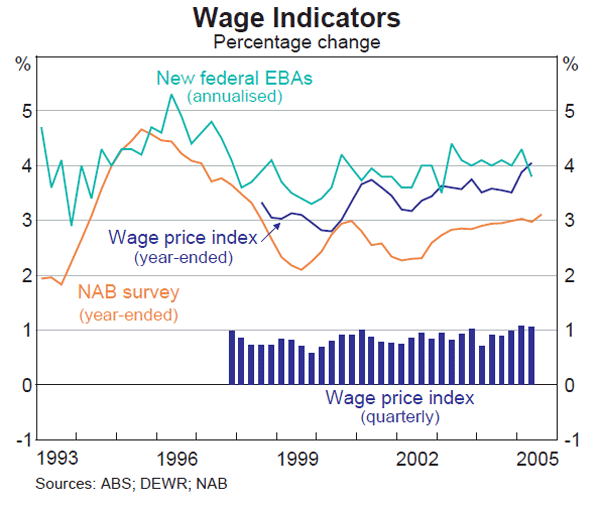
On balance, aggregate data suggest that wage pressures remain stronger in the public than the private sector. Within the private sector, the WPI indicates that the construction and mining industries continue to experience significant wage pressures, consistent with the strength of demand in these sectors. However, according to liaison, wage pressures are also pronounced in the business services sector and are becoming more broad-based across industries.
Business surveys continue to show that firms have been experiencing difficulty finding suitable labour (Graph 65). In addition, the Bank's liaison with firms indicates that there has been a widespread increase in rates of staff turnover. Consequently, firms are more actively using non-wage remuneration – such as bonus payments, more flexible work arrangements and more generous leave provisions – to attract and retain employees. They are also increasing the frequency of their salary reviews and rates of promotion. In this climate of labour shortages and increased staff turnover, firms are reporting an increase in staff training costs.
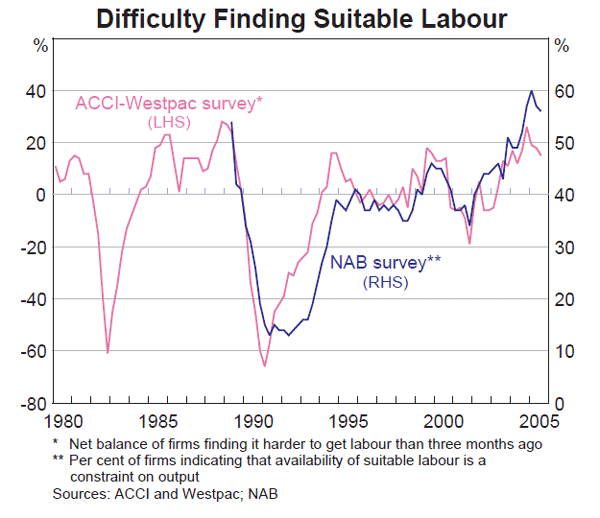
Unit labour costs, which measure total labour costs per unit of output, are estimated to have grown by 0.6 per cent in the June quarter to be 4.2 per cent higher over the year. Although wage growth has been firm, the strength in unit labour costs mostly reflects a fall in estimated labour productivity over the year to June, which has been more pronounced than the typical cyclical slowdown.
Inflation expectations
Business surveys suggest that both near-term inflationary pressures and expectations of future price growth currently remain contained, though the persistence of high oil prices raises the risk that these expectations could become dislodged. Both the ACCI-Westpac survey of manufacturers and the Dun & Bradstreet survey reported a fall in the net balance of firms increasing selling prices in the September quarter and expecting to increase prices over the coming months. The NAB survey reported that, in aggregate, final product price inflation fell slightly in the September quarter, although there was a pick-up in retail price inflation. Both economy-wide and retail price inflation were expected to remain broadly steady in the December quarter.
The Bank's survey of market economists, conducted following the release of the September quarter CPI, indicates that the median forecast for CPI inflation over the year to June 2006 increased to 3 per cent (Table 15). The median expectation over the year to June 2007 remains unchanged at 2½ per cent. Union officials expect inflation to be somewhat higher; the median expectation is for year-ended inflation to rise to just under 3½ per cent by June 2006 and then to stabilise around this level.
| Year to June 2006 | Year to June 2007 | |||||
|---|---|---|---|---|---|---|
| May 2005 |
August 2005 |
November 2005 |
August 2005 |
November 2005 |
||
| Market economists(a) | 2.6 | 2.7 | 3.0 | 2.5 | 2.5 | |
| Union officials(b) | 2.8 | 2.8 | 3.4 | 3.0 | 3.5 | |
| (a) RBA survey (b) ACIRRT survey |
||||||
The median inflation expectation of consumers, as reported in the Melbourne Institute survey, was 5.2 per cent in October. While this series is now well above its average over the past five years, it has shown little correlation with either current or future inflation in recent years. The medium-term inflation expectations of financial market participants, which are calculated as the difference between nominal and indexed bond yields, have edged slightly higher since the last Statement on Monetary Policy, averaging 2.8 per cent over the past three months.
Inflation outlook
The CPI increase of 3 per cent over the year to the September quarter was noticeably higher than outcomes in recent quarters, and owed largely to the sharp rise in petrol prices. Nonetheless, higher fuel prices and rising input costs have so far had only limited effects on general price inflation at the consumer level. That is, to the extent that they are forcing up some prices in the economy, it appears that these increases have not been passed on to consumers or they have been offset by slower rises or declines in other prices. Overall, based on a range of indicators, the Bank's assessment is that underlying inflation has remained well contained at around 2½ per cent over the past year. Indeed, quarterly underlying inflation outcomes have been remarkably stable for about the past two years. However, wage data for the first half of 2005 suggest that the strength in the labour market has resulted in a pick-up in wage pressures at an aggregate level.
The Bank's forecast for inflation is based on the assumption that oil prices remain around the late-October average level of US$62 per barrel. The forecasts envisage solid growth in domestic production (GDP growth of 3–3½ per cent over the forecast period) and a slowing in the growth in domestic expenditure towards that of production. Given this background, underlying inflation is expected to increase gradually over the year ahead, reflecting the current upward drift in the growth of labour costs. There will also be a greater contribution from import prices owing to stronger global inflation for raw materials and the waning of the effects of the 2002–2003 currency appreciation. However, the effect of these pressures on inflation is expected to be more muted than might otherwise have been the case, given the moderation in domestic demand growth, the prospect of a mild easing in labour market conditions, and the scope for firms to absorb some portion of rising costs in margins (which remain reasonably healthy both in aggregate and in some key sectors). Based on these factors, underlying inflation is expected to increase to around 3 per cent by mid 2006, but not to rise beyond this level in the medium term. Higher petrol prices will keep headline CPI inflation above underlying inflation for the next few quarters, but assuming no further rises in petrol prices, the two inflation measures would be expected to converge from late 2006.
One risk to the inflation outlook is that there could be no easing in labour market conditions, and hence further upward pressure on wages and other labour costs. Oil prices present another risk, given the prominence of petrol prices for households, and their potential to raise consumers' inflation expectations. Increases in transport costs and prices of petroleum-derived products could also flow through into wider second-round price increases by firms. These risks would increase if oil prices were to rise above current levels. But, as highlighted in the Box on oil usage, with oil expenditures representing only 2½ to 3 per cent of GDP, the current oil price increase is a much smaller cost shock to the Australian economy than was the case in the late 1970s. Furthermore, risks to the inflation outlook are tempered by the experience of the past decade or so, which suggests that expectations about low inflation have become well entrenched in the broader community, and that markets for many goods and services are subject to a higher level of competition from both domestic and external sources.
Box C: Oil Usage in the Australian Economy
Average capital city petrol prices rose from around $1.00 per litre to $1.19 per litre over the year to the September quarter, as a result of a sharp run-up in global crude oil prices. Increases in petrol prices have a direct impact on the CPI and boosted the annual inflation rate significantly in the September quarter. This Box provides some further discussion of the impact of higher oil prices on the Australian economy, focusing on oil usage. Overall, the data suggest that the recent strength in oil prices should represent less of a shock to the aggregate price level than some earlier global oil shocks.
While the sharp increase in petrol prices has attracted a lot of attention, petrol accounts for a relatively modest share of spending by Australian households. Automotive fuel has a base-period weight of 3.8 per cent in the new 15th series of the CPI. In the broader national accounts measure of household consumption expenditure, automotive fuel accounted for a little less than 3 per cent of total household spending in 2004/05. The household expenditure survey (HES) suggests there are only modest differences in the share of petrol in consumption across different income levels.
With an average weekly petrol consumption of around 35 litres per household, the price increase of nearly 20 cents per litre over the year to the September quarter would have added nearly $7 to the average weekly household fuel bill (taking it to about $42 per week), assuming no change in the volume of petrol purchased.[1] However, one response of households to higher prices has apparently been to look for ways to reduce their fuel consumption, such as cutting back on discretionary driving or changing to more fuel-efficient vehicles. The June quarter national accounts point to some reduction in the amount of fuel consumed by households in recent quarters, and sales of small cars have picked up significantly recently.[2]
Households are not the only consumers of petrol: petrol and other oil-derived products are also used by businesses as inputs into the production process. In addition, part of the amount spent by users on fuel represents taxes, which are a transfer within the economy. The broadest measure of the importance of oil in the economy is the ratio of total oil usage to GDP. For the economy as a whole, the importance of oil has steadily declined over the past 25 years as firms and households have become more efficient users of oil, largely in response to rises in oil prices in the late 1970s, reflecting the introduction of import parity pricing and the subsequent second OPEC oil shock. In addition, energy-intensive sectors now make up a smaller share of the economy as the services sector has expanded. As a consequence, oil intensity, defined as the number of barrels of oil consumed per unit of real GDP, is now around 40 per cent lower than at the end of the 1970s (Graph C1). Expenditure on oil consumption has fallen from a short-lived peak of 5–6 per cent of GDP around 1980 to 2–2½ per cent in recent years (Graph C2).[3] If oil prices were to remain at current levels with no change in oil consumption, this ratio would rise to around 3 per cent in 2005/06. This represents a substantially smaller cost shock to the Australian economy than occurred in the late 1970s.
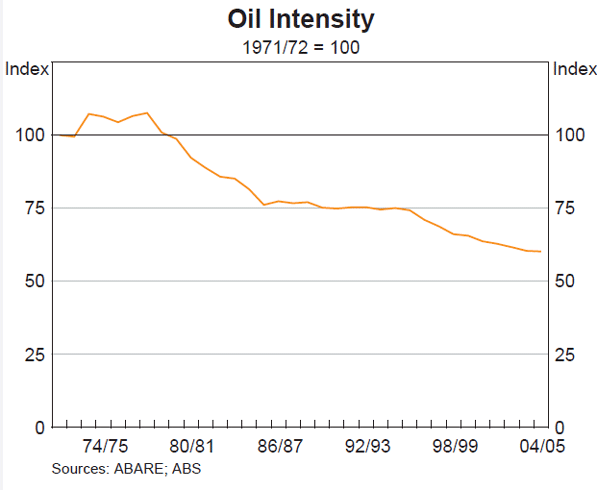
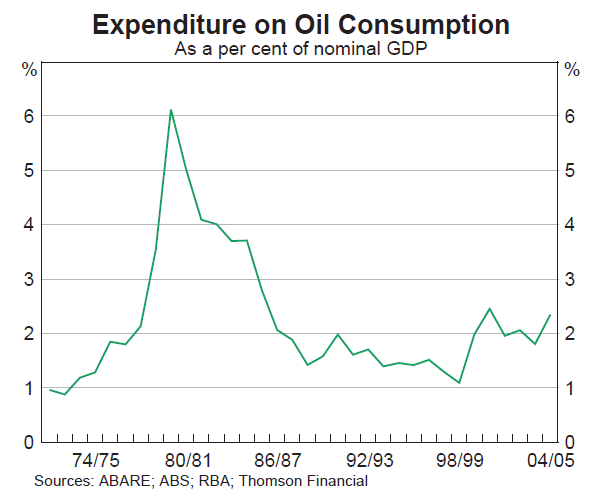
Box D: The Introduction of the 15th Series Consumer Price Index
The Australian Bureau of Statistics (ABS) regularly reviews the content of the CPI so that it accurately reflects the prices of goods and services acquired by households. In the September quarter 2005, it introduced the 15th series of the CPI. This series contains several significant changes. In particular, the weights on all the expenditure components of the CPI have been updated in line with the 2003/04 Household Expenditure Survey, financial services prices have been included for the first time, and prices for personal computers are now directly estimated.[1]
Changes to the weighting scheme
The update to the CPI weighting scheme is standard practice for the ABS every five years or so. The weights are updated with a view to accounting for such things as the introduction of new goods and services and minimising the substitution bias inherent in a price index like the CPI. This bias arises because the CPI is constructed for a fixed basket of goods and services and does not allow for the fact that consumers are likely to change the bundle of products they purchase between weighting periods, increasing their purchases of products for which relative prices have fallen, and reducing their purchases of products for which relative prices have risen. Graph D1 compares the base-period weights for the 10 expenditure groups (excluding the new Financial & Insurance Services group) with those in the previous series of the CPI, which were based on household expenditure in 1998/99. There has been an increase in the expenditure shares for housing, communication, health, education and recreation since the introduction of the 14th series CPI in 2000. In contrast, there has been a fall in the expenditure shares for transportation, food, clothing & footwear, household contents & services, and alcohol & tobacco.
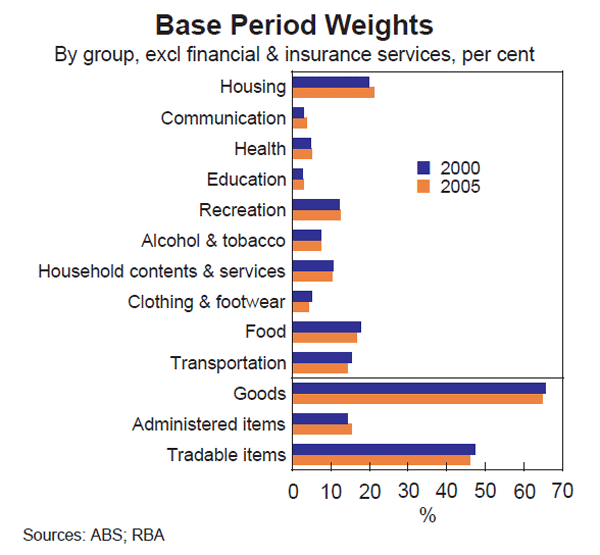
While the quantity of each product within the CPI basket remains constant until the next re-weighting of the CPI, relative price movements can cause changes in the effective weights of goods and services in the calculation of the CPI. For example, petrol prices rose more quickly than the overall CPI between the June quarter 2000 and the June quarter 2005. The increase in the relative price of petrol implies that the effective weight on automotive fuel increased over the period of the 14th series CPI. Therefore, the change in effective weights between the June quarter and the September quarter 2005 were in some cases quite different to the change in the base-period weights. The most significant increases in effective weights have been for audio visual & computing equipment, telecommunication, and motor vehicles (Graph D2). In contrast, the most significant decreases have been for automotive fuel, beer, and takeaway meals & fast foods. The effective weight of automotive fuel has fallen from 4.6 per cent in the June quarter to 4.1 per cent in the September quarter (abstracting from the effect on weights of introducing financial services in the 15th series); including financial services, it has fallen from 4.6 per cent to 3.8 per cent. According to the ABS, the fall in this weight partly reflects reduced usage of petrol due to improvements in the fuel efficiency of passenger vehicles.
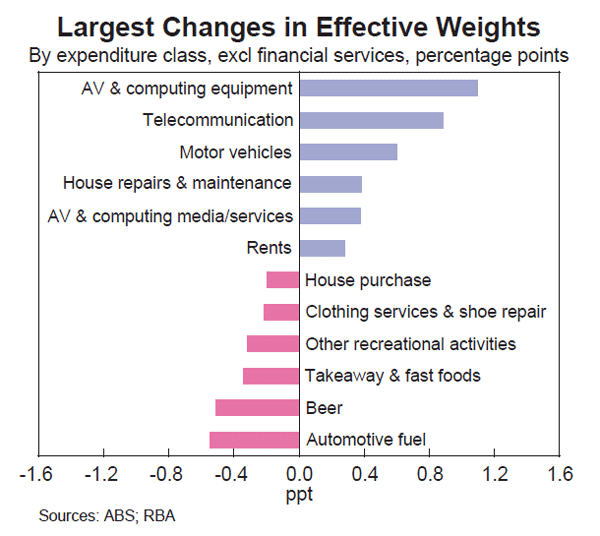
Introduction of financial services prices
The other significant development in moving to the 15th series of the CPI is the inclusion of the new financial services price index (FSPI), which measures the cost of services consumed by households due to the acquisition, holding and disposal of financial and real assets. The FSPI comprises two component indices. The deposit & loan facilities price index, which has been given a base-period weight of 4.5 per cent in the CPI, covers facilities provided to households by deposit-taking institutions. It is designed to measure both the direct fees and indirect costs for households engaged in borrowing and lending transactions. The other financial services price index, which has a base-period weight of 3.3 per cent in the CPI, aims to measure the price of services provided by stockbrokers and real-estate agencies when households transact in shares and property, plus any government charges on property transfers such as stamp duties.
The indirect cost component of the deposit & loan facilities price index is measured by ‘interest rate margins’ – the difference between lending and deposit rates faced by households. For example, if lending rates were to increase relative to deposit rates, this would increase the implicit ‘price’ of financial services for households.[2] As financial institutions tend to adjust their lending rates more quickly than their deposit rates in response to changes in the cash rate, interest rate margins (and hence the deposit & loan facilities price index) will, to some extent, be correlated with movements in the cash rate.[3]
While financial services prices have not previously appeared in the CPI, the ABS has recently made available experimental data for the FSPI and its two component price indices dating back to 1998. These data suggest that the FSPI rose by 2.6 per cent over the year to the September quarter, slightly slower than the headline inflation rate (Graph D3). These data also indicate that movements in the FSPI have been significantly less volatile than price changes for items, such as fruit & vegetables and automotive fuel, that are frequently excluded from measures of underlying inflation.
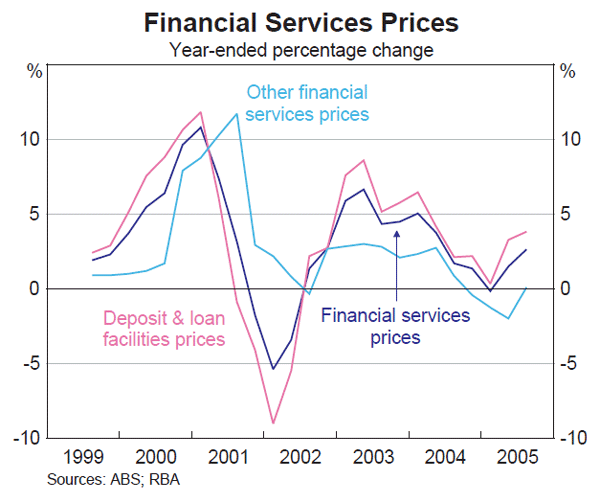
The price series for deposit & loan facilities differs in important ways from the mortgage interest charges component that formed part of the CPI between 1987 and 1998. That item was generally thought to distort the signal about inflationary pressure provided by the CPI. The mortgage interest charges component of the CPI included a gross interest rate, rather than an interest rate margin, which is the case for the new deposit & loan facilities series. Consequently, when interest rates were raised to combat inflationary pressures, the mortgage interest component of the CPI would rise correspondingly, adding to inflation as measured by the total CPI. Given the larger movements in interest rates in that period, that component was one of the most volatile CPI components, with the volatility of quarterly price changes around three times the median volatility of other CPI components. Furthermore, mortgage interest charges accounted for a larger share of the CPI than does the new deposit & loan facilities component.
Prices for personal computers
The other important change introduced in the 15th series CPI is the pricing methodology for personal computers. In general, price indices, such as the CPI, should measure ‘pure’ price changes – that is, changes that adjust for the characteristics or quality of individual goods. However, quality adjustments for goods which experience rapid changes in quality, such as computers, are difficult. The international ‘best practice’ has been to develop hedonic price indices that relate changes in a product's price to changes in its underlying characteristics; for example, a computer's processing speed, memory and hard drive space. Until now, the ABS' approach to pricing computers has been to adopt the hedonic price index calculated by the Bureau of Labor Statistics in the US as a proxy price measure for computers in Australia (after adjusting for factors such as exchange rate movements). From the 15th series onwards, the ABS will instead adopt its own hedonic pricing model.
Footnote Box B
The data used in this box were sourced from the Insto/TD Securities and the Stone & McCarthy Research/Deutsche Bank fund manager surveys. Survey participants include almost all of the large fund managers active in the Australian market. These managers also invest a sizeable proportion of life insurance companies' reserves. [1]
Footnotes Box C
The figure of around 35 litres per week (including a small amount of diesel and LPG) can be obtained either from the 2003/04 HES or the 2004 Survey of Motor Vehicle Use. It also appears consistent with data for economy-wide sales of fuel in Australian Petroleum Statistics published by the Department of Industry, Tourism and Resources. [1]
More generally, Australian and foreign studies have typically found that a 10 per cent increase in petrol prices tends to reduce the demand for fuel by around 1–2 per cent in the short term and by around 5–6 per cent in the longer run. [2]
From 1978, the graph is based on the volume of domestic oil consumption valued at world prices. Prior to that it is based on an average of world and domestic oil prices, weighted according to the estimated share of imports. The price for domestically produced oil was largely fixed at below-market levels until August 1975, so Australian oil consumers were partially insulated from the direct price effects of the first OPEC price shock. Prices for domestically produced oil were increased towards world prices over the following three years, with the shift to import parity pricing completed in the August 1978 budget announcement. [3]
Footnotes Box D
There have been a few other changes, generally involving the renaming and reclassification of expenditure class items within the CPI. Overall, the new classification results in the number of expenditure classes increasing from 89 to 90 while the number of expenditure groups will remain the same at 11. See the ABS Information Paper, ‘Introduction of the 15th Series Australian Consumer Price Index 2005: Reissue’ (Cat No 6462.0) for further details. [1]
While in principle the interest rate margin is the difference between lending and deposit rates, in practice this margin is measured as the difference between the interest rate on a given deposit or loan facility and a ‘reference rate’ at which the financial institution incurs no risk. For operational simplicity, this reference rate has been chosen as the midpoint between interest rates on deposits and loans. [2]
The deposit & loan facilities price index has, however, been introduced to the CPI well after increased competition in the financial sector had induced a process of margin compression. For a discussion of this period of adjustment, see ‘Banking Fees in Australia’, Reserve Bank of Australia Bulletin, April 2003, pp 1–6. [3]